

Kuelap Fortress: The Complete Visitor’s Guide
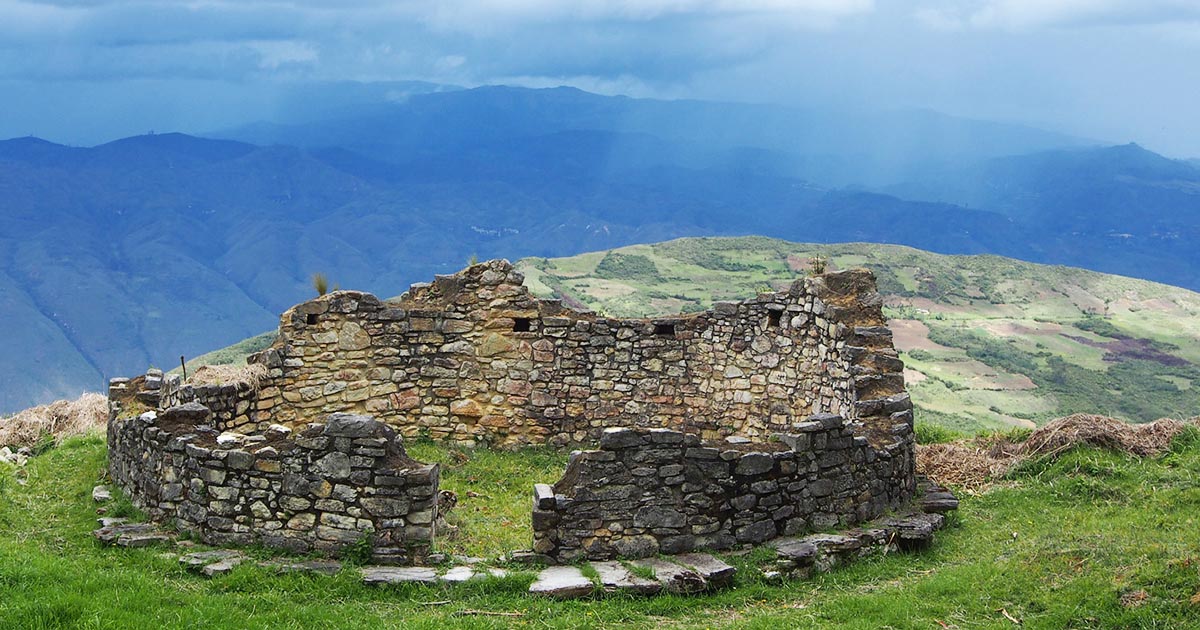
The Chachapoyas people, also known as the Cloud Warriors, were a thriving civilization in Peru, long before the Inca. They constructed the massive pre-Inca ruins of Kuelap, spelled Kuélap in Spanish. This relatively unknown fortress hides in the high Andes Mountains of northern Peru, far off the beaten path and widely under the radar.
Nevertheless, this fortress is in the running to become one of Peru’s top archaeological sites. Kuelap could certainly become the next Machu Picchu. Get off the beaten path and visit one of Peru’s most fascinating destinations before the crowds!
Table of Contents
At a Glance
History of kuelap, when to go to kuelap, how to travel to kuelap, how to visit kuelap, kuelap tours, where to stay, other sites nearby , kuelap vs. machu picchu, plan your trip to kuelap.
- Where is Kuélap located ? The Utcubamba River Valley in the northern Amazonas region of Peru.
- What is the altitude of Kuelap ? 9,842 feet (3,000 meters) above sea level.
- Who built Kuelap? The indigenous Chachapoyas people.
- When was Kuelap built ? The majority of the fortress was built between 900 and 1100 CE. Some structures date back to the 6th century.
- What was Kuelap used for? The tall, fortified walls and watchtower suggest the Chachapoyas people used the site for defense from invasion. Kuelap also housed more than 5,000 people at a time and became a functioning city with areas dedicated to religion, craft production, and other societal roles.
- When is the Kuelap Fortress open ? The site is open from 8 AM to 5 PM every day. The cable car is closed on Mondays.
- How many hours does it take to visit Kuelap ? It takes about 8 hours, considering roundtrip transportation from/to the city of Chachapoyas (the capital of Peru’s Amazonas Region). Tours last about one to two hours.
- Is Kuelap worth visiting? Definitely!
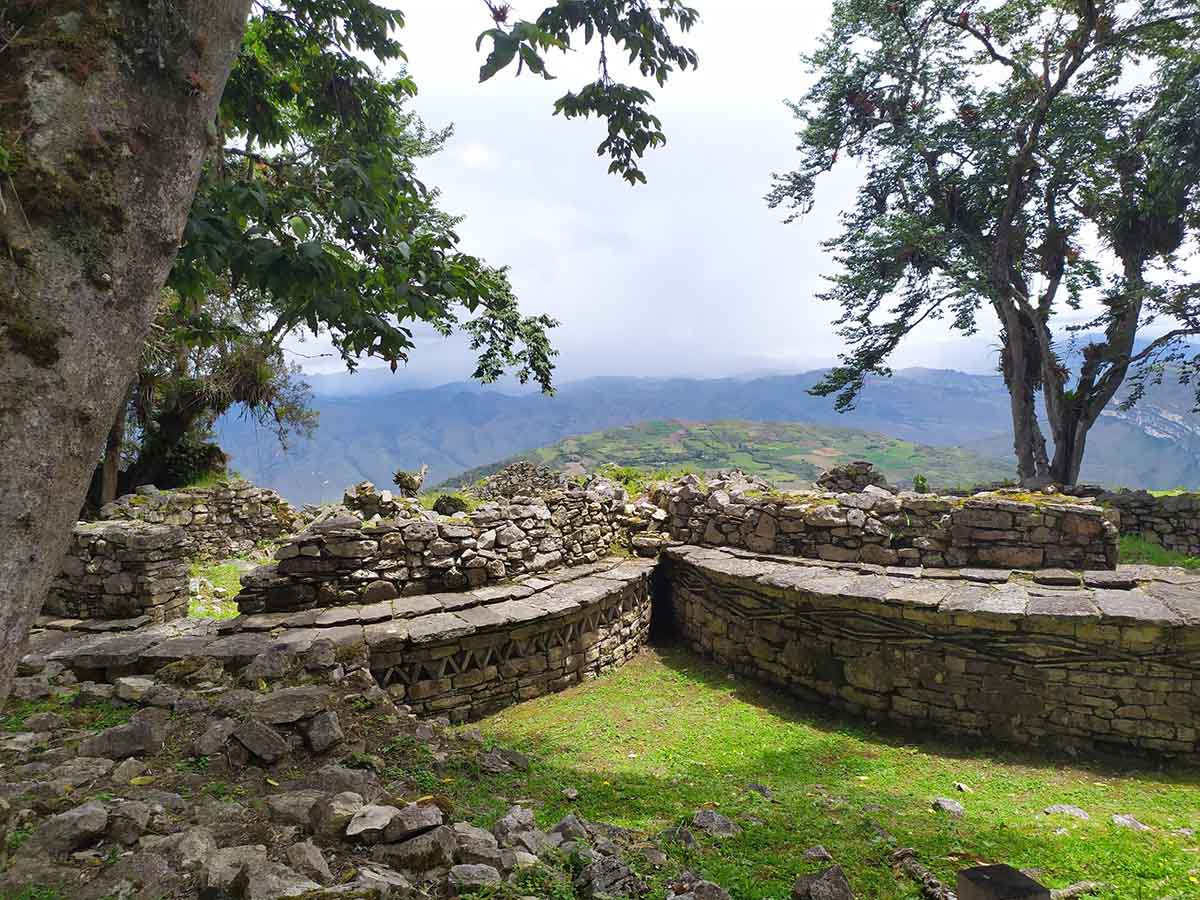
Intricate stone work on the exterior of the round houses of Kuelap. Photo by Mikey Blount of Peru for Less.
The occupation of this area began 2,400 years ago, around 400 BCE. Built by the Chachapoyas civilization, the majority of the Kuelap Fortress we know today was built between 900 CE and 1100 CE. However, certain areas of the ruins today date back to the 6th century CE or up until the Inca conquest of the region in the 1400s.
Kuelap Fortress was a political center for the pre-Inca society known as Chachapoyas. This society flourished from roughly 900 CE to 1400 CE. Nestled on a mountaintop above the Utcubamba River Valley in northern Peru, the archaeological site is about 1,968 feet (600 m) long and the outer walls tower about 62 feet (19 m) high.
The native Chachapoyas people occupied the site until the Inca Empire conquered the area around 1470 CE. Although the Inca tried to wipe out the Chachapoyas during their invasion, they were unsuccessful. A genetic study published in 2017 found that the indigenous people living in the region today have the same Chachapoyas DNA of their ancestors.
The Spanish conquered the area around 1570. Soon after, the site was abandoned for hundreds of years. A judge from Chachapoyas rediscovered the site in 1843, but it remained off the mainstream radar until the 1980s. Archaeologists continue studying the site today.
Kuelap is currently a UNESCO World Heritage Site candidate . If accepted, the inclusion of the site will help it gain international recognition as well as support for infrastructure development projects in the region.
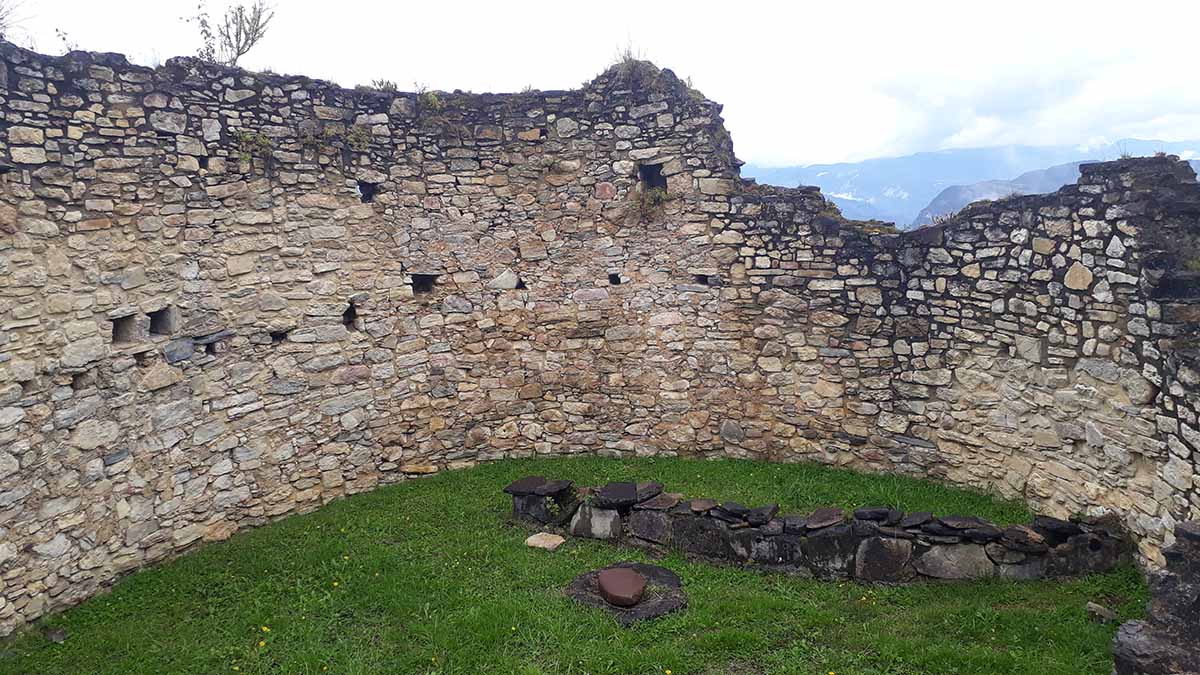
Stone walls of Kuelap have stood for centuries if not millennia. Photo by Liz Sperling of Peru for Less.
Weather in Kuelap is split between two seasons: rainy and dry. Weather wise, the best time to go to Kuelap is during the dry season, from May to September. You can expect mostly sunny days and limited rain. Temperatures are cooler, but the high altitude sun is still strong.
However, the rainy season, from October to April, can be a pleasant experience all the same. Temperatures are typically warmer, but chances of precipitation are higher. A light mist adds an extra layer of mystery and magic to the Kuelap Fortress, making for some unique photos. In addition, the rain means the nearby Gocta Falls are at their fullest, even more powerful and breathtaking.
There are many more domestic than international visitors. Because of this, Kuelap tends to get busy on long holiday weekends. Take a look at the Peruvian holiday calendar here to see the official holidays. However, keep in mind that even on holiday weekends, the number of visitors at Kuelap still pales in comparison to Machu Picchu on any given day.
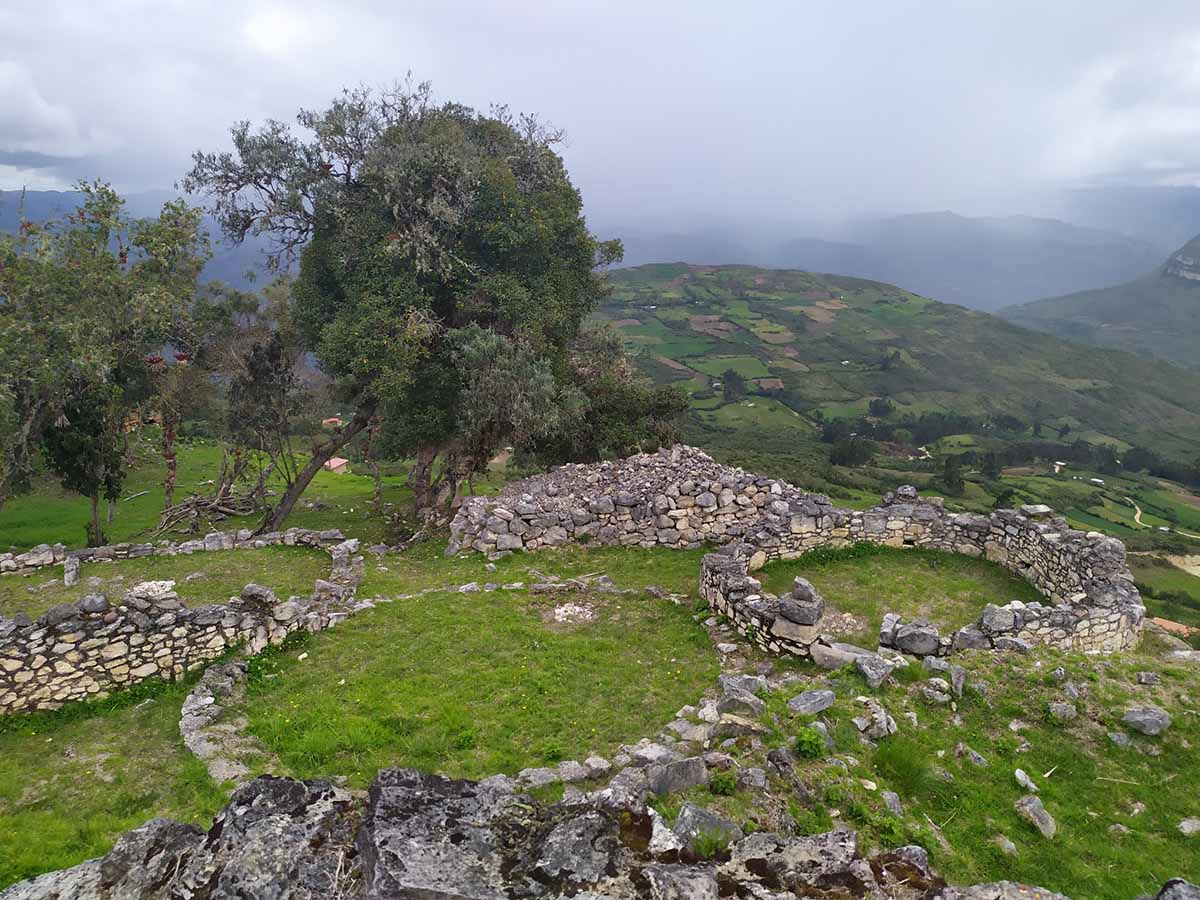
Circular stone buildings are quintessential of Kuelap Fortress. Photo by Mikey Blount of Peru for Less.
To reach Kuelap, you must first travel to the Amazonas Region. There are four main routes to the area: through Tarapoto, Jaén, Chiclayo, or directly to Chachapoyas. The most common and popular route is from Ja é n to Kuelap .
Keep in mind that you typically need two full days for travel in and out of the region. While you may have some time in the evening upon arrival or morning of your departure, it is not sufficient to visit Kuelap the same day as a flight in or out.
Amazon Rainforest Tours:
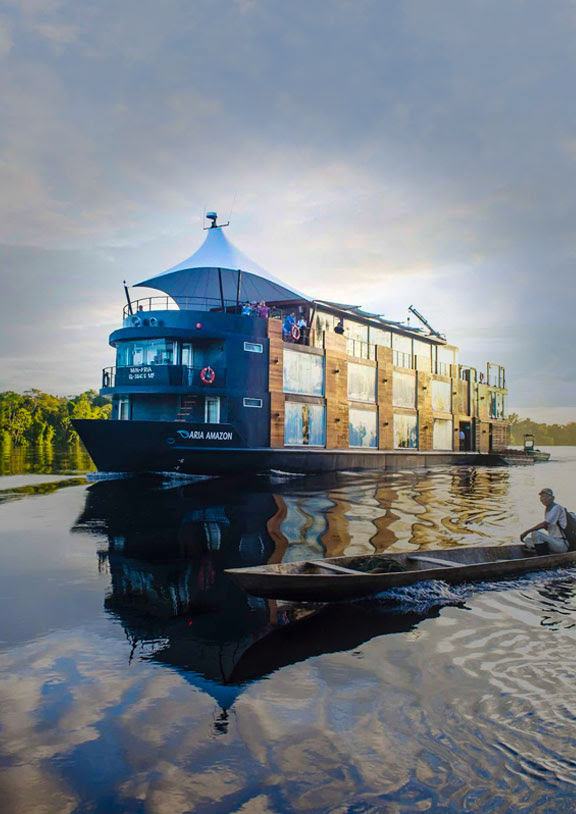
Through Jaén
There are a handful of daily flights to Jaén (JAE) from Lima (LIM). The flight lasts about 1.5 hours, and typically arrives in the afternoon or evening. From the Jaén airport, the main plaza of Chachapoyas is about 4 hours driving away and our top hotel pick, Gocta Andes Lodge, is about 3.5 hours away.
Through Tarapoto
With multiple daily flights from Lima, flying to the jungle city of Tarapoto (TPP) is another option to reach Kuelap. After the hour-long flight, you will need to stay overnight in Tarapoto before embarking on an 8-hour drive the next morning. On the way, you will stop at various locations in the Alto Mayo Protection Forest and experience the biodiversity of the Peruvian jungle .
Through Chiclayo
There are several daily flights from Lima to Chiclayo (CIX) , another top destination in northern Peru. From Chiclayo, you can head to Chachapoyas on an overnight bus ride. This journey takes around 10 hours. While you can head to the Kuelap ruins the same morning of arrival, you will probably be tired after a bumpy overnight bus ride. We recommend visiting Kuelap with fresh eyes, so if you have time, consider waiting until the next day for your Kuelap tour.
Through Chachapoyas
While the Chachapoyas airport (CHH) is the closest to Kuelap, flights are only available two or three times per week from Lima. The flights are offered by Atsa Airlines, a small national airline. This route uses small planes, like the Bombardier Q400, that hold around 76 passengers, whereas the flights to Jaén or Tarapoto use larger aircraft. The airport is 15 minutes from Chachapoyas’ main plaza, or an hour from Gocta Andes Lodge.
There is discussion to expand the Chachapoyas airport so it can receive more flights and larger aircraft. This would give travelers better and easier access to the area. The plans are supported by a number of major airline operators . The government is set to release a master plan for renovations in October 2020.
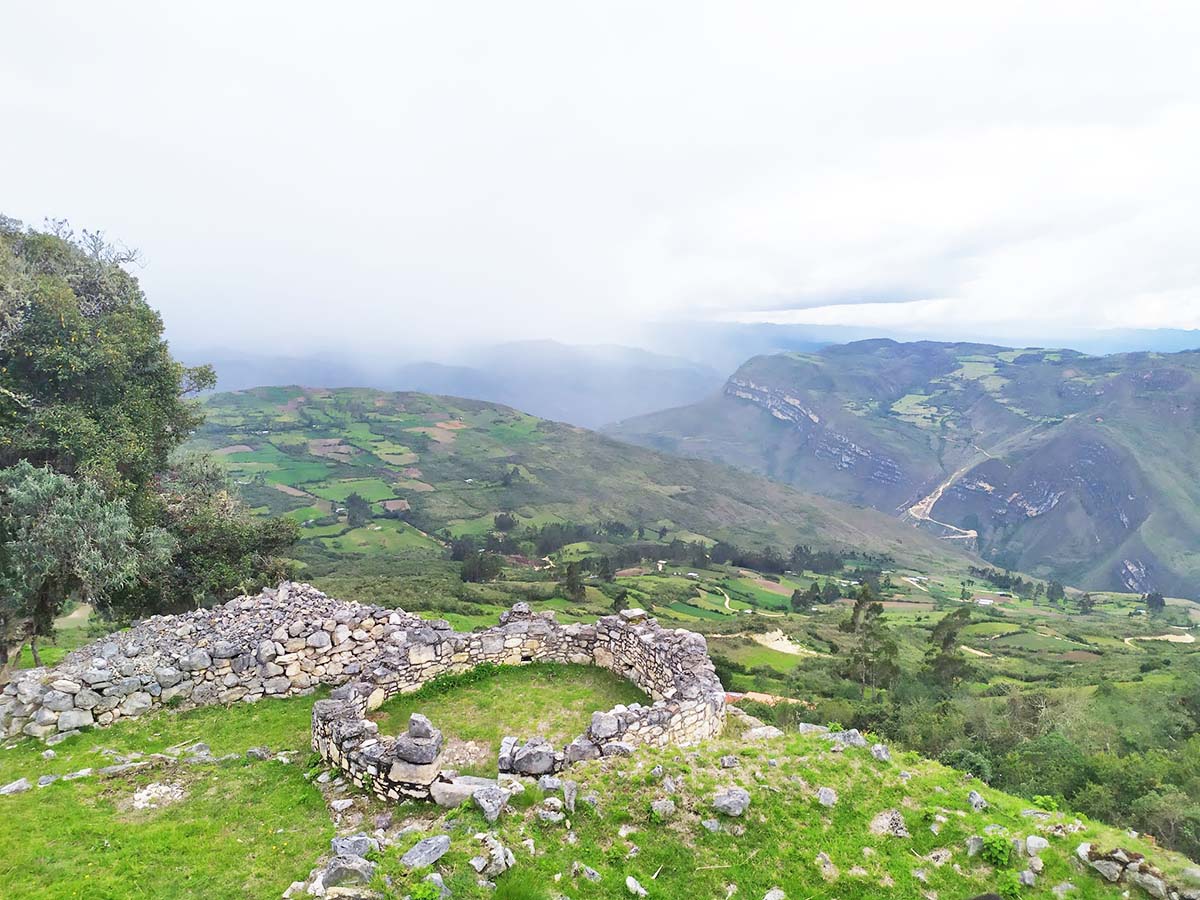
Circular stone ruins of Kuelap. Photo by Mikey Blount of Peru for Less.
While most tours include transportation from and to your hotel, it is important to know the logistics of how to get to Kuelap before embarking on your tour.
Tours to Kuelap take a full day, starting in the morning at around 8 AM and lasting about 8 hours, depending on where you are staying. From Chachapoyas or hotels nearby, you are a drive, cable car ride, and short walk away from the fortress. To reach the Kuelap cable car station, the first step is to drive one hour from Chachapoyas or 1.5 hours from Gocta Andes Lodge.
The recent installation of a cable car system has greatly improved the ease of access. It carries visitors from the town of Nuevo Tingo to an area that is a 30-minute uphill walk from the archaeological site. Horses are available to hire for the walk from the cable car station to the entrance of Kuelap if necessary.
The Kuelap cable car system stretches about 14,435 feet (4,400 m) up the mountainside, taking about 20 minutes each way. This new improvement cuts out 90 additional minutes driving on a winding dirt road. Keep in mind that the cable car is open Tuesdays through Sundays from 8 AM to 5 PM. If traveling to Kuelap on a Monday, additional driving time should be considered.
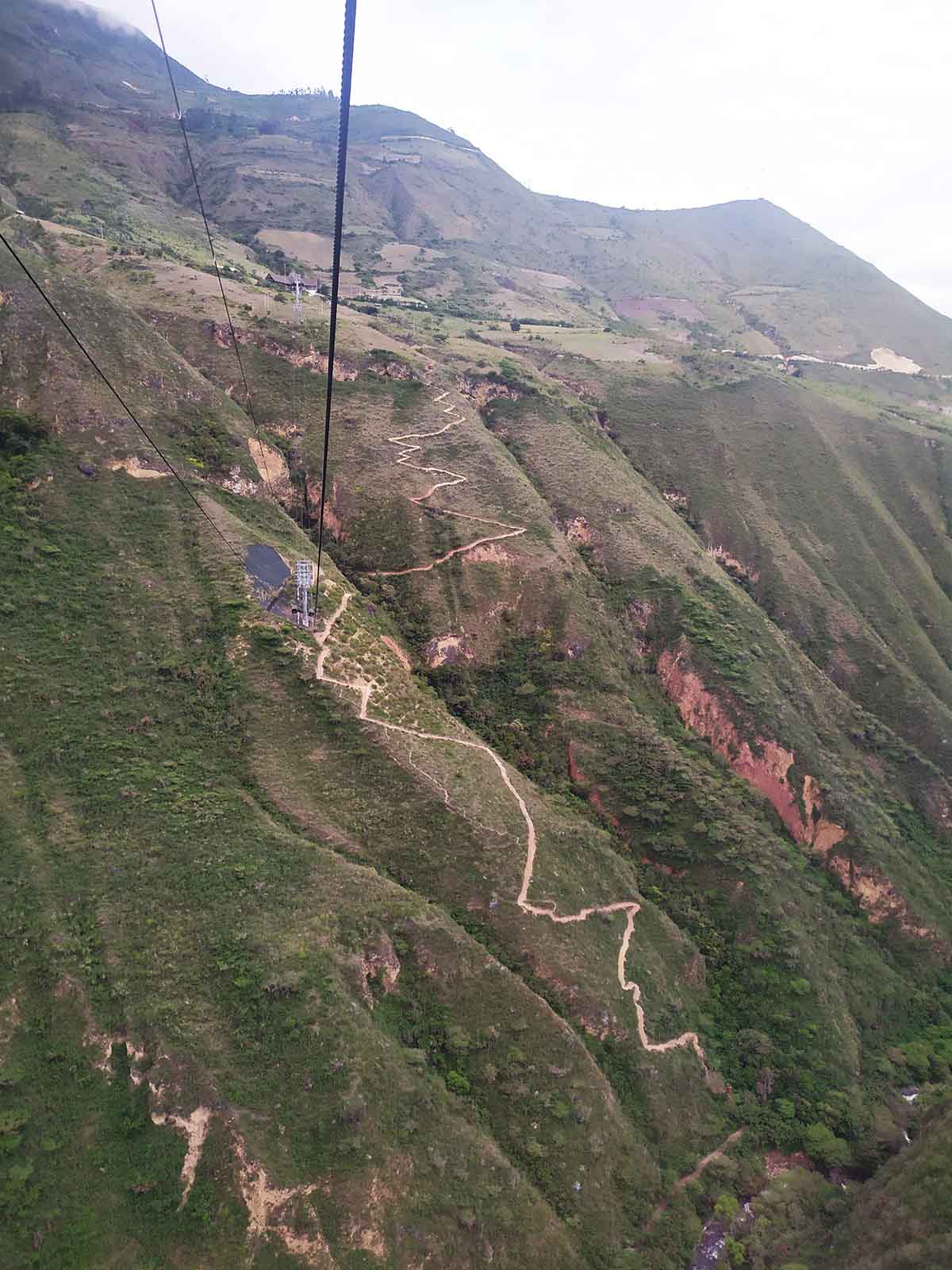
The Kuelap cable cars passing through the mountains. Photo by Mikey Blount of Peru for Less.
Alternative: Hiking to Kuelap
Adventurous travelers can also hike to or from the fortress on a 6 mile (9.8 km) trail. In place of one way on the cable car, the uphill hike to the fortress takes about 4.5 hours, ascending 3,940 feet (1,200 m). Going downhill is quicker and easier, but still tiring.
Five rest points along the trail offer much appreciated shade and seating, but be sure to bring enough water and snacks to last the duration of the hike.
Three or four day treks to Kuelap and other sites nearby are available for the super adventurous.
While the journey to Kuelap is rather complicated, once you arrive, you quickly realize it was worth it. Touring this ancient site with a local guide illuminates the unique history and culture of the Chachapoyas people. Tours typically last about one to two hours, with more time for individual exploration afterwards.
With certain areas dating back to the 6th century and others up to the 15th century, you can see the history of the Chachapoyas people with your own eyes. During your tour, there are several features of the Kuelap architecture to look out for.
The massive outer wall reaches a towering 60 feet (19 m) high. Over 400 round houses make up the majority of the site, distinct from any of the ruins of Peru . Geometric and figurative decoration on the exterior walls make the site all the more unique.
Beyond the spectacular ruins themselves, views from the Kuelap ruins make you feel as though you are hidden in the shroud of the majestic Andes Mountains. Small local restaurants offer a la carte menus for lunch or a snack before you head back to your hotel in the afternoon.
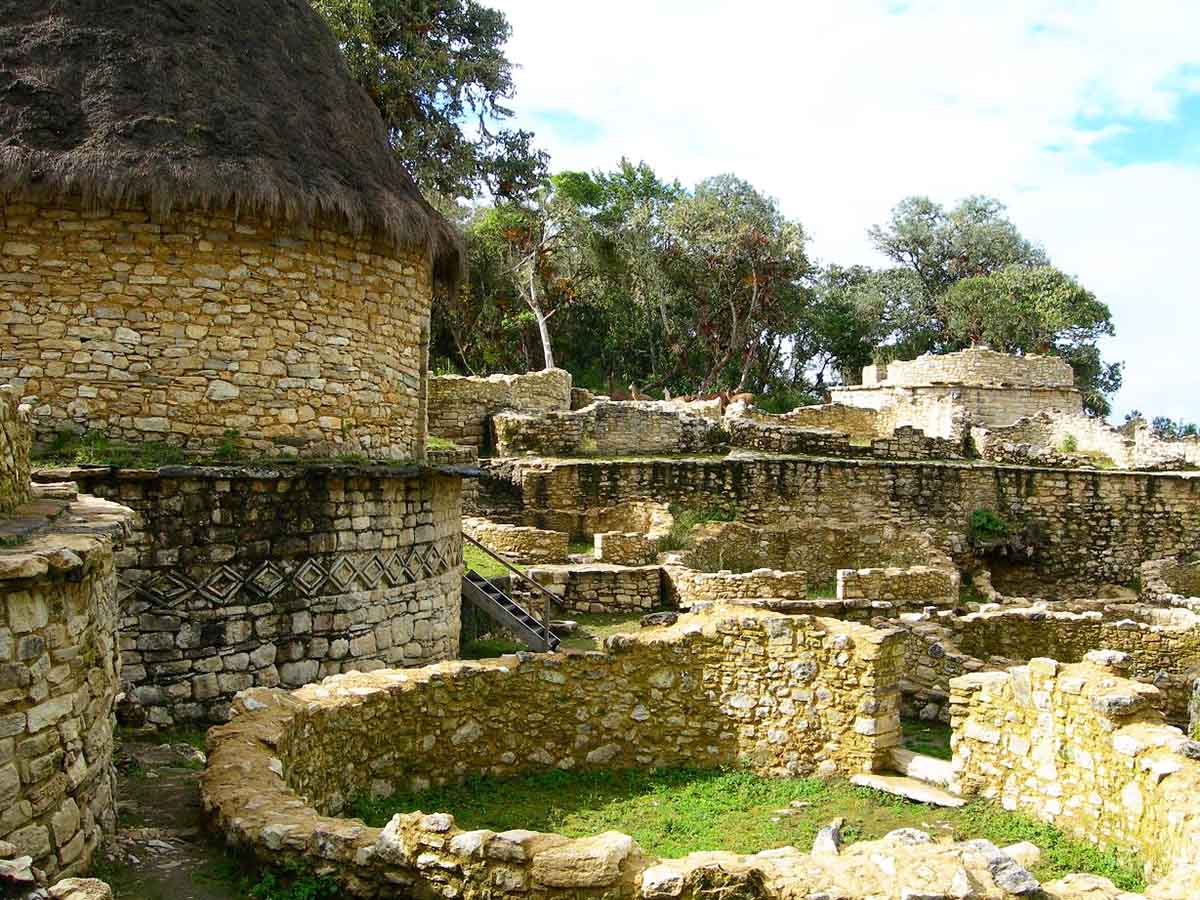
Several round houses in Kuelap have restored roofs. Image: File: Kuelap by José Porras, used under CC BY-SA 2.5 / Compressed from original
What to Bring on Your Kuelap Tour
Come prepared for your Kuelap adventure ! Be sure to bring the following items along for your tour.
- You need to have your original passport (or Peruvian ID) that was used to purchase the tickets.
- Hiking shoes or comfortable sneakers are a must.
- We also recommend bringing a rain jacket or poncho.
- Due to the high altitude, the sun is very strong, so bring along a hat, sunglasses, and sunscreen.
- Pack a water bottle and some light snacks.
- The Kuelap Fortress of northern Peru sits about 9,842 feet (3,000 m) above sea level. If you are concerned about altitude sickness, check out our altitude sickness guide here and pack medication or another remedy.
Kuelap Points of Interest
There are several main points of interest in the Kuelap Fortress.
- The main entrance has a trapezoidal shape with mythical and magical figures displayed on large stones.
- The second entrance on the opposite side may have been an escape route and/or a place where offerings to the gods were launched.
- The third entrance , the smallest, was for deliveries of daily and ceremonial items.
- The main temple was the most important religious structure in Kuelap. Many human remains were buried here and only the elites had access to this temple.
- The circular platform was the residence of an important elite family. This site is near the main temple.
- The external wall surrounds the site. The massive, thick wall took several generations to finish. Human burials and other offerings were found in the bases of the wall.
- The tower is where many re-buried human remains were found, along with many pebbles. Researchers suggest that the pebbles may have been used as projectiles to hurl at the sky, calling for rain.
- The north sector is home to the tower and faces an abyss on the western side.
- The central sector has three rectangular buildings. According to researchers, these rectangular structures originated during the Inca occupation and are superimposed on original Chachapoyas circular structures.
- The south sector has two platforms completely covered by circular houses. Its perimeter wall is the highest point of the fortress.
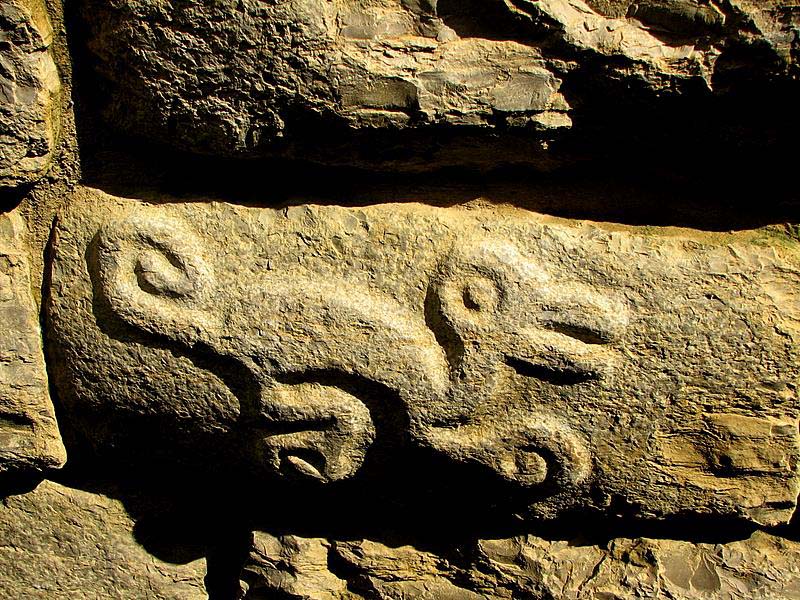
Stone carvings decorate the exterior of Kuelap’s many round houses. Image: Inscripciones en Kuelap 2 by Jorge Gobbi , used under CC BY 2.0 / Compressed from original
Keep in mind that this is a remote destination and there are no 5-star luxury options available. However, the 3-star Gocta Andes Lodge has everything you need for a comfortable stay. While there are quite a few lodges in the area, Gocta Andes Lodge stands out among the rest. An infinity pool overlooking the Gocta Falls in the distance is an impressive perk of staying here. Each room has its own balcony or terrace with views of the falls as well.
It takes about 1.5 hours to drive from Gocta Andes Lodge to the cable car station that heads to Kuelap. The Gocta Waterfall is a 3.4 mile (5.5 km) hike from Gocta Andes Lodge.
There are two other top hotels near Kuelap. The Gocta Natura Reserve is also close to the Gocta Waterfall. Kentitambo , also known as the Hummingbird Inn, is across the street from the Leymebamba Museum and closer to Kuelap. Budget travelers can find several small hotels and hostels in the area.
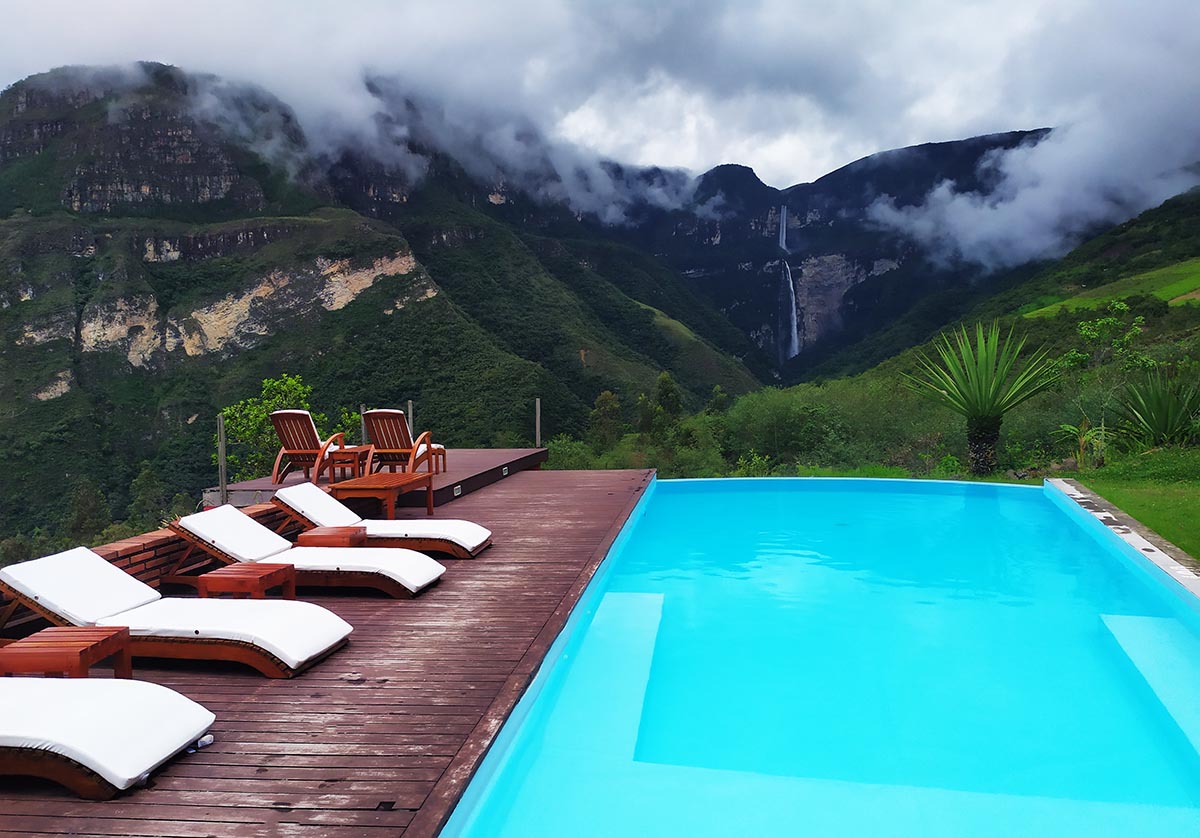
The Gocta Andes Lodge overlooking the Gocta Waterfall. Photo by Mikey Blount of Peru for Less.
While Kuelap is the main highlight in the area, there are several other impressive places to visit nearby. Consider adding any of the following options to your Kuelap travel package with an extra day!
- Visit the impressive Gocta Waterfall on a full day tour. Hike to the falls while birdwatching for a chance at seeing the Andean cock-of-the-rock, the national bird of Peru.
- Visit Karajia to see several sarcophagi typical of the Chachapoyas funerary traditions. Afterwards, enter the Quiocta Caverns where you will find interesting rock formations and ancient cave drawings from the Chachapoyas people.
- Head to the Revash Mausoleums and Leymebamba Museum , where you will find 261 mummies and learn about the Chachapoyas culture. If you happen to take this tour on a Sunday, make a stop at Yerbabuena to visit the largest market in the region.
- Head on a day trip to the Mayo River Valley , the land of incredible coffee, breathtaking orchids, and towering palms known as aguajales . This trip explores the biodiversity of the forest nearby, bringing you closer to nature and the Amazon Rainforest.
- Take a day to visit Huembo Reserve and the Pomacochas Lagoon for a chance to see the endangered marvellous spatuletail hummingbird and up to 10 other species of native hummingbirds.
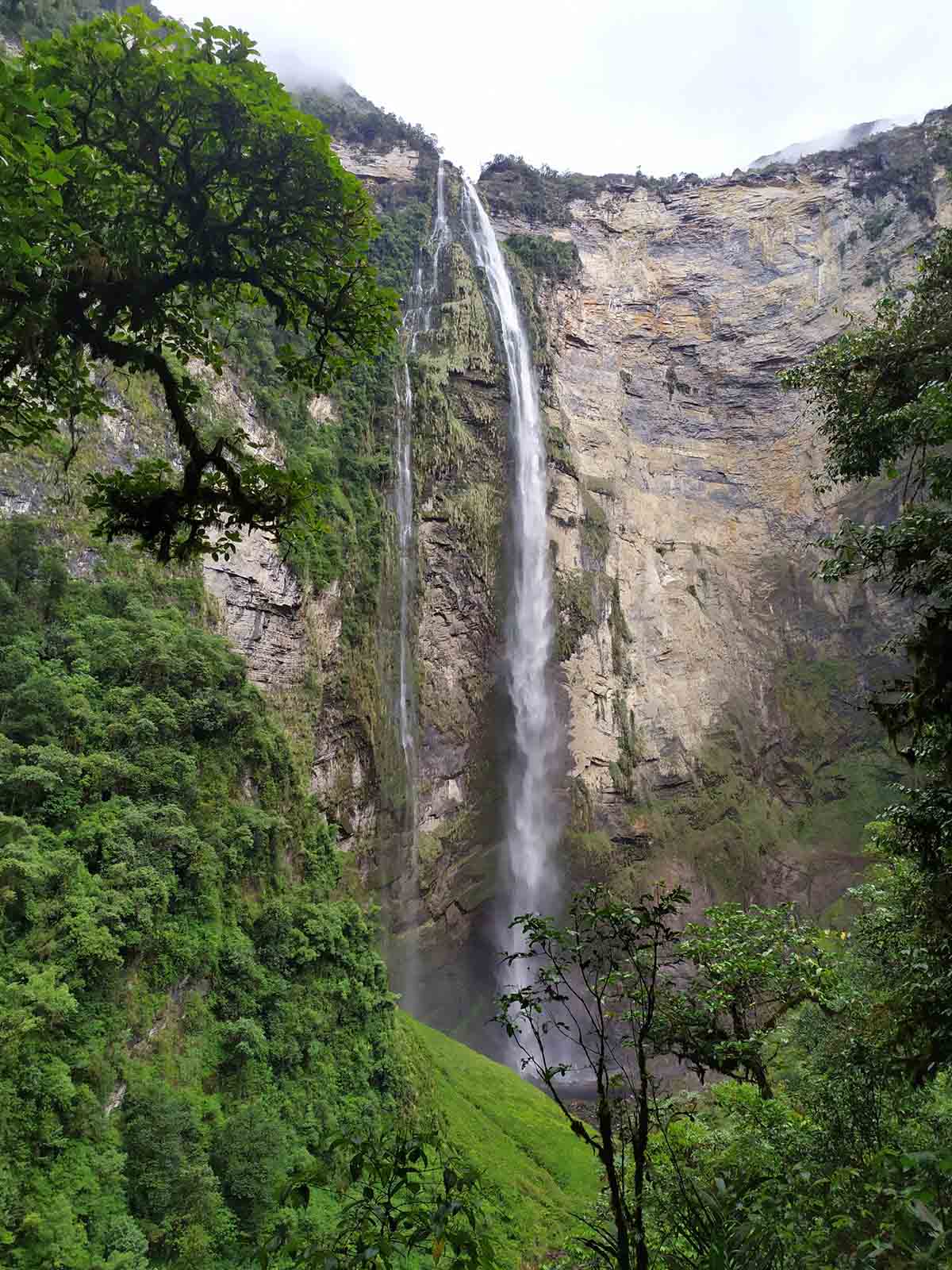
The Gocta Waterfall. Photo by Mikey Blount of Peru for Less.
Government officials in the Chachapoyas region are pushing for infrastructure developments to increase the popularity of the Kuelap Fortress. The goal is to make Kuelap the second most visited attraction in Peru, behind Machu Picchu .
But, how does Kuelap compare with Machu Picchu, the most famous ruins in Peru ? Both sites are breathtaking, but they are quite different. From different times, cultures, and regions of Peru, the two sites offer visitors their own distinct experience.
Machu Picchu Tours:

Similar to the Incas, the Chachapoyas built their citadel as close to the sky as possible, and therefore, closer to their gods. Incredible stone masonry is on display at both sites and the longlasting ruins prove the incredible skill both cultures had at shaping, moving, and building from massive stones. Both sites are located where the Amazon Rainforest and the Andes Mountains meet, offering a unique cloud forest environment at both sites.
Nevertheless, the cultural differences between Kuelap and Machu Picchu are irrefutable. According to the Peruvian Ministry of Culture , the social and political structures, urban planning, architecture, and decorative arts differ between the sites.
Kuelap, sometimes known as the “Machu Picchu of the North,” is a fascinating alternative to Machu Picchu . While Machu Picchu certainly deserves its reputation, consider adding Kuelap to your itinerary for an untouched look back in time.
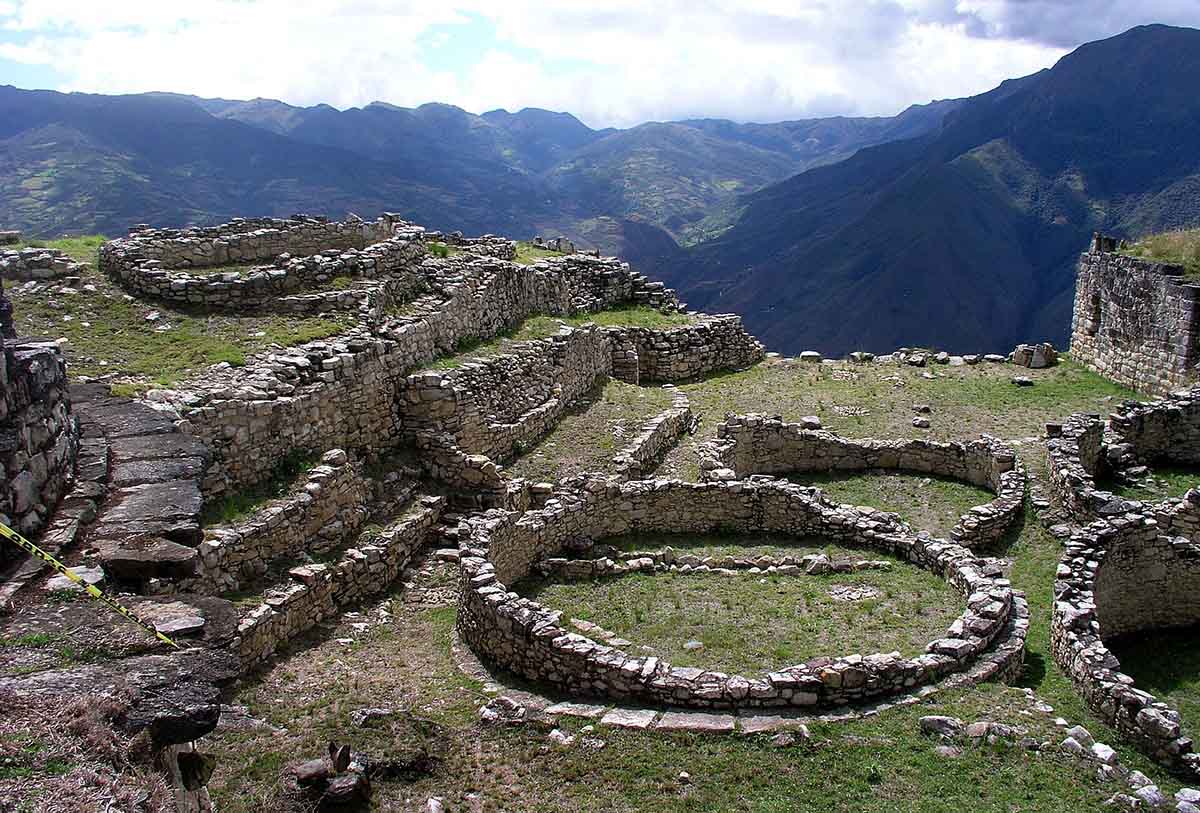
A sunny day at Kuelap. Image: File:P1011081mod by JYB Devot, used under CC BY-SA 4.0 / Compressed from original
There is a wealth of natural and historical wonders in Chachapoyas, but they are currently under-appreciated due to the remoteness and limited infrastructure. Right now, Kuelap is Peru’s best kept secret. Are you up for an adventure?
Travel through time and get a taste of pre-Inca history on a fully customizable Peru tour package . Contact us to chat with an expert Travel Advisor to plan your dream trip to Kuelap!
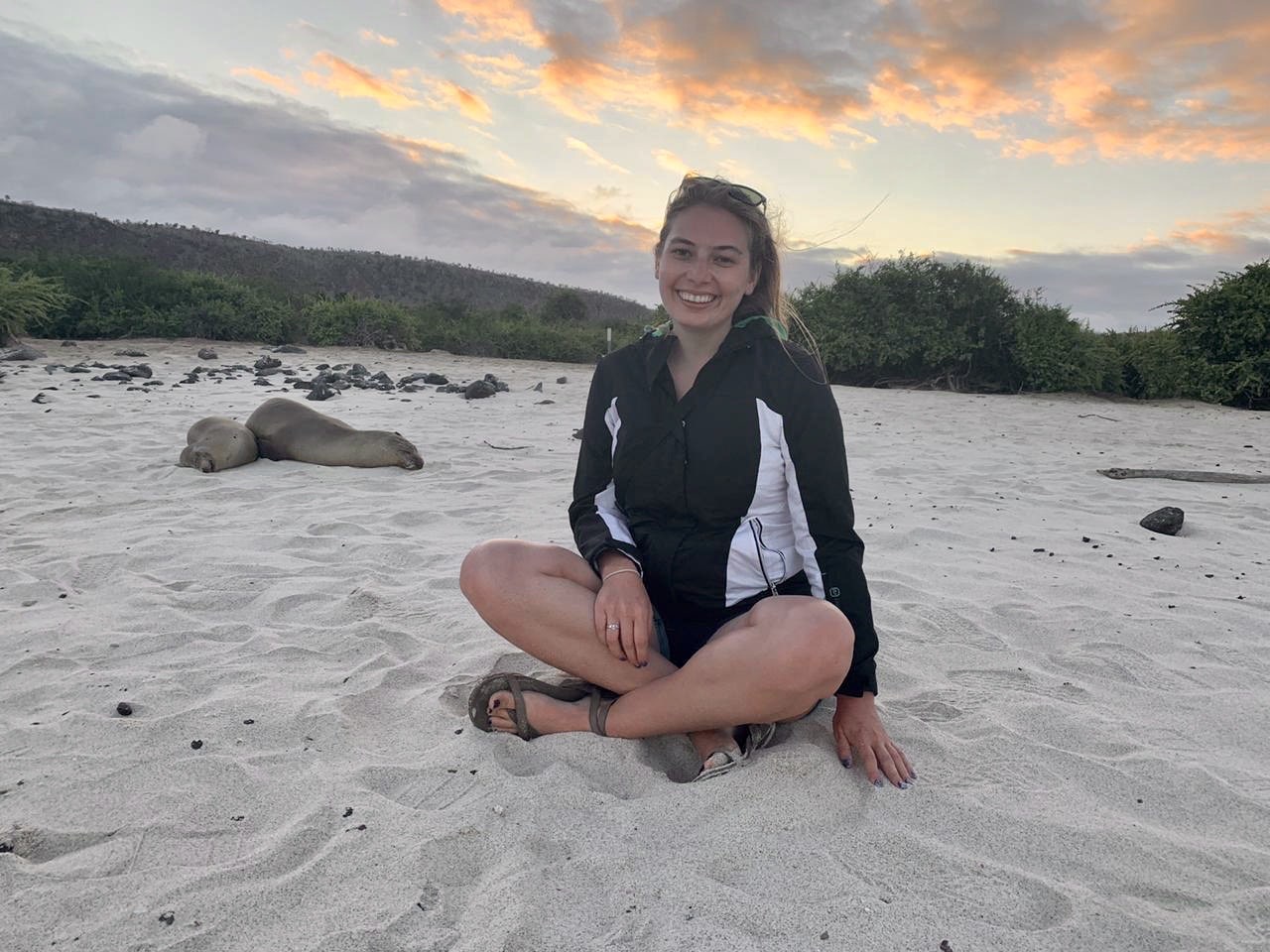
Born and raised in small town Michigan, Melissa began traveling at 15 and hasn’t stopped since. After calling Havana and Paris her temporary homes, she moved to Lima in 2018. Since then, she has traveled extensively in Peru and across the continent to Argentina, Brazil, Chile, Ecuador and the Galapagos Islands. She loves trying new foods, learning about history, and chasing waterfalls.
Tags: Chachapoyas , Kuelap , Kuelap Fortress , Kuelap Ruins , northern Peru
Related posts:
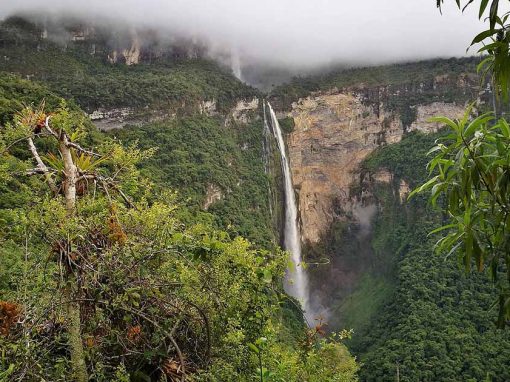
Gocta Waterfall: Peru’s Tallest Free-falling Cascade
Visit one of the world’s tallest waterfalls on your trip to Peru! Learn all about the Gocta Waterfall, a breathtaking place where the Amazon Rainforest meets the Andes Mountains.
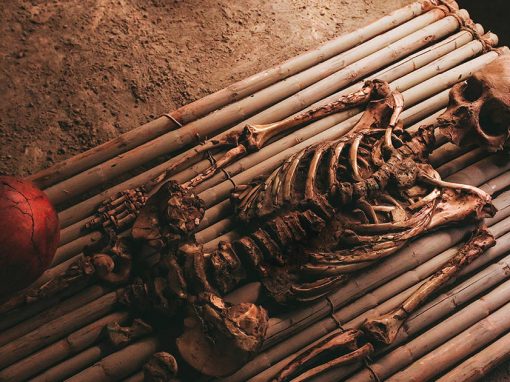
A northern journey to ancient treasures in Peru
Peru’s ancient treasures in the northern cities of Chiclayo and Trujillo rival those of any archaeological site in the Americas.

Start Planning!
Explore all our best-selling packages
See All Packages
Book With Confidence
We're flexible! Postpone your tour with zero cost up to 10 days prior to departure.
The following preferences are optional , but will help enhance your trip's customization.
Are you interested in visiting the best restaurants in Latin America?
Book with confidence
We're flexible! Postpone your tour with zero cost up to 10 days prior to arrival with open dates
( Optional. You may choose more than one)
TIP: Tell us the destinations you have in mind.
- Tour Packages
- Machu Picchu
- Amazon Rainforest
- Galapagos Islands
- Sacred Valley
- Lake Titicaca
- 5000+ Reviews
- Travel Guides
- Work With Us
- Responsible Travel
Rely on our expert services to customize a unique experience. Comfortable hotels, tours, and all transportation. 24/7 in-trip support.
Our Peru For Less Travel Blog is a living library of travel information, knowledge, and advice from a group of travel loving experts who live, work, eat, and breathe all things in South America.
"Our tours are Fully Customizable and leave 365 days a year!"
- Destinations
1-817-230-4971
Sales & travel support
Kuelap & Chachapoyas
Enigmatic Amazonas region in Peru is a lesser-known destination with plenty of amazing sites and breathtaking scenery. Discover the Chachapoyas culture , a pre-colonial civilization that occupied the north of Peru long before the Incas. Enjoy a cableway ride to the Kuelap Fortress on the top of a cliff. Travel along the Utcubamba River, spotting gorgeous hummingbirds, let the Andean community of La Jalca show you their timeless traditions and ancient knowledge, or hike in the middle of the cloud forest to Gocta waterfalls , the third-highest on the planet!
Northern Peru: Chan Chan and Gocta Waterfall
Kuelap fortress & gocta waterfall, short inca trail & the rainbow mountain, machu picchu & the amazon rainforest.
- Cusco & Machu Picchu
Short Inca Trail to Machu Picchu & Cusco
E-bike journey through southern peru, lake of the condors & northern peru, luxury amazon river cruise & machu picchu, choquequirao trek & tambopata national reserve, wildlife tour in peru, nature at its purest, ausangate lodge to lodge trek & machu picchu, machu picchu & galapagos tour, peru and bolivia in two weeks, machu picchu & the nazca lines, peru adventure journey, inca trail to machu picchu, authentic peru experience, authentic peru luxury trip, peru family adventure, peru food tour, the flavors of peru, peru honeymoon adventure, peru off the beaten path: ica & paracas, machu picchu & the tambopata national reserve, off the beaten path cusco, southern peru experience, highlights of northern peru, highlights of southern peru, peru highlights: machu picchu & kuelap, huancaya & off the beaten path peru, peru hidden treasures, ayacucho: peru central highlands, peru off the beaten path: central highlands, peru off the beaten path: southern peru, peru off the beaten path: northern peru, discover the soul of peru.
Thousand of kilometers traveled, countless cities visited, always new discoveries right at your fingertips. Be the first to know all about our trips and the latest news.
- Amazon Rainforest
- Arequipa & Colca Canyon
- Ayacucho & Central Highlands
- Bolivia & Uyuni Salt Flats
- Ecuador & Galapagos
- Kuelap & Chachapoyas
- Paracas & Nazca Lines
- Puno & Lake Titicaca
- Trujillo & Chiclayo
- Piura & Tumbes
- Peru Family Tours
- Peru Highlights
- Peru Honeymoon Tours
- Peru Luxury Tours
- Nature & Wildlife
- Peru Off The Beaten Path
- Responsible Travel
- Trip Finder
- Start planning here
- Get in touch
- Sign up for e-mail

Introducing Northern Peru, home to the ‘new Machu Picchu’
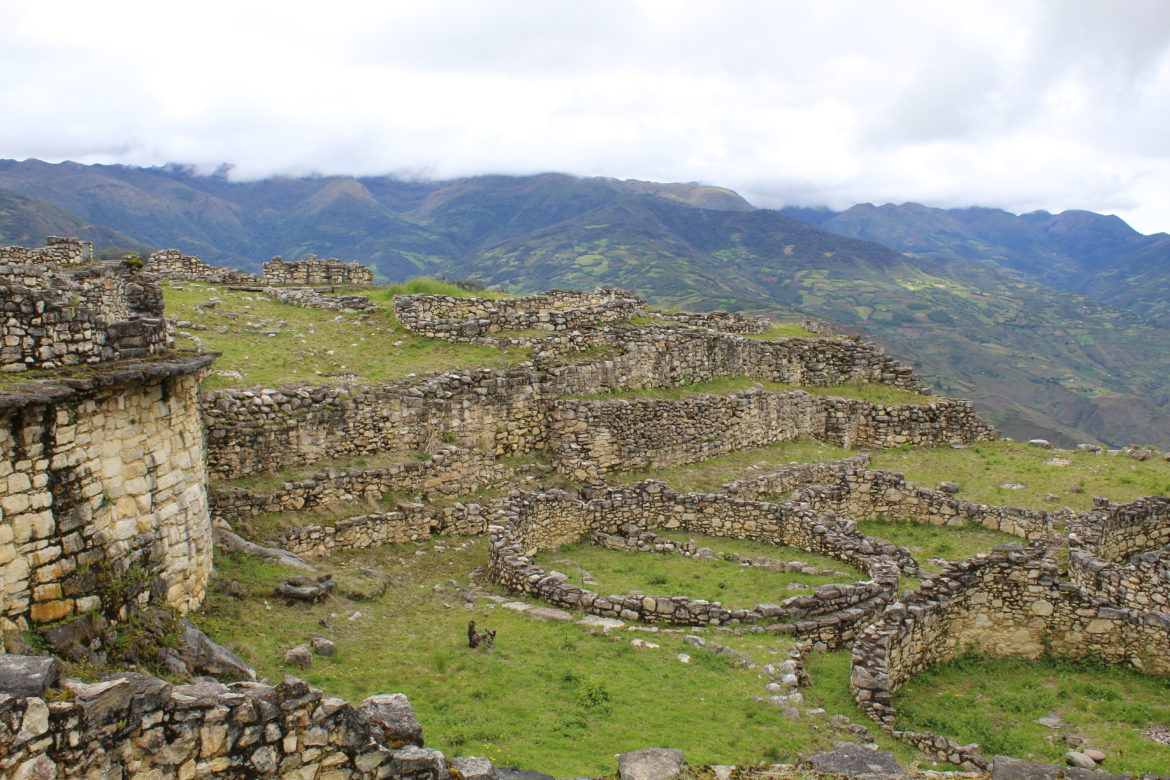
Imagine Machu Picchu. Spectacular, historic, utterly iconic. And then magnify the history and minus the tourists, and you’ve got a sense of Kuelap.
You’ve probably never heard of Kuelap’s pre-Incan ruins and how they pre-date Machu Picchu’s, but it’s time their wonders got some recognition. Because they’re only the tip of the iceberg when it comes to lesser-discovered Northern Peru, a region we’re so excited to be taking travellers to for the first time ever.
Why? Northern Peru just has a different feel to it. Compared to more visited regions and more standard routes, it shows a sleepy, scenic side of the country that very few see: tiny Andean towns, dramatically lush landscapes and all. Not only are there fewer crowds and a more laid-back atmosphere, the highlights really are unbelievable.
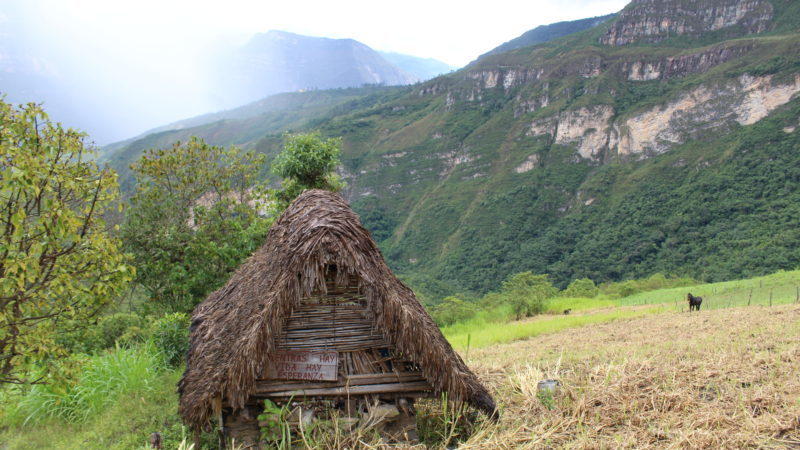
Hiking in Northern Peru
Coming up: a quick guide to this barely-visited region (hint: it includes ones of the world’s highest waterfalls), what you need to know about the ruins of Kuelap, and all the cool activities Intrepid’s 7-day trip has to offer:
The allure of Northern Peru: the must-see spots
A few of our favourite historic and scenic parts:
Kuelap – the ‘new Machu Picchu’
Now, don’t get us wrong – we absolutely love Machu Picchu . We will never tire of standing at its Sun Gate, watching the mist lift off the mountain, feeling oh so small. It really is once-in-a-lifetime, a symbol of South America. But heading to Kuelap is truly like heading back in time. Mostly because you’ll be surrounded by so few other visitors that you can really enjoy the views from the hilltop fortress. And because you can really get lost in your imagination of what this place was like when the Chachapoyas civilization were here.
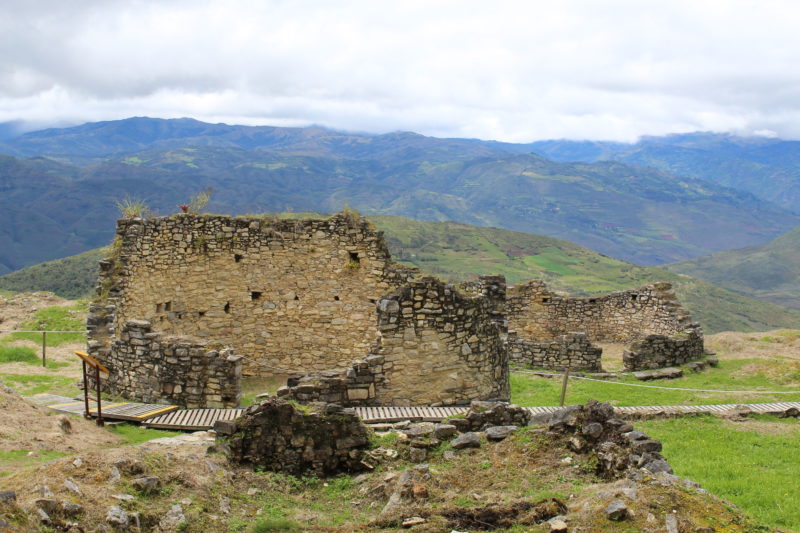
Yes, Kuelap is a pretty special place. It’s one of Peru’s most significant archaeological sites and it’s no longer difficult to get to thanks to the cable car that’s just been completed. Though it will get busier in time, visiting now is a perfect way of coming face-to-face with history. And of taking in Northern Peru’s jungle-clad, panoramic vistas.
READ MORE: 7 REASONS TO VISIT PERU (THAT AREN’T MACHU PICCHU)
The site itself is built on a mountain-top that sits in a cloud forest 3,000 metres above sea level. If that isn’t cool enough, it’s sheer age should be. It’s been estimated that construction on Kuelap began around the 6th-century, coinciding with the rising Chachapoyas culture. Its colossal walls and complex interior architecture reveal administrative, religious, ceremonial and other residences.
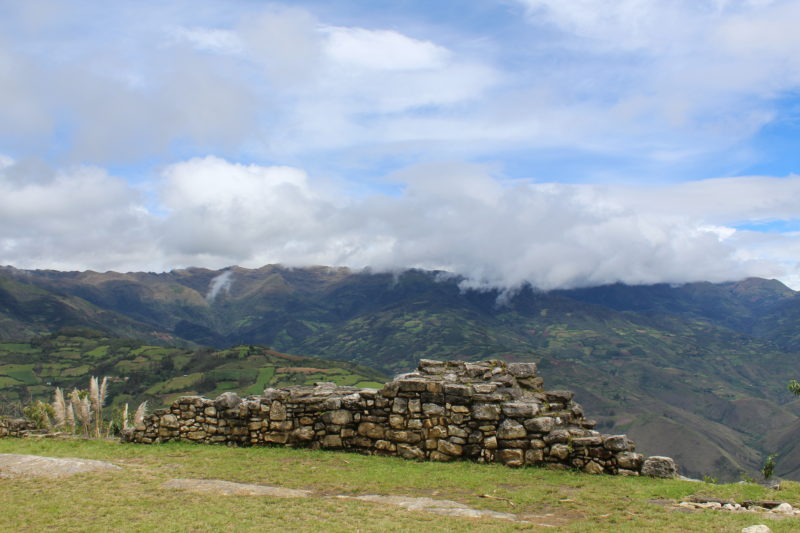
The view from Kuelap
STILL not impressed? Kuelap is considered the largest stone ruin site in the New World. It’s comprised of 10 times the number of stone blocks that were used for the Great Pyramid of Giza. There you have it. A site that’s more than worth a day or so of your time. And, as The Guardian put it, the ‘new Machu Picchu’.
Gocta Falls – a little-known beauty
You’ve probably heard of Iguazu Falls , you may have been to Niagara Falls, and you’ve likely dreamed of Iceland’s array of waterfalls . But, let us be the first to tell you that the Gocta Falls are as spectacular as they are unknown.
That’s no exaggeration – until 2005 the two-level waterfalls sat hidden in the Andes, known only to locals. It’s only been in the last decade or so that they’ve gained more recognition. They’re still incredibly under the radar.
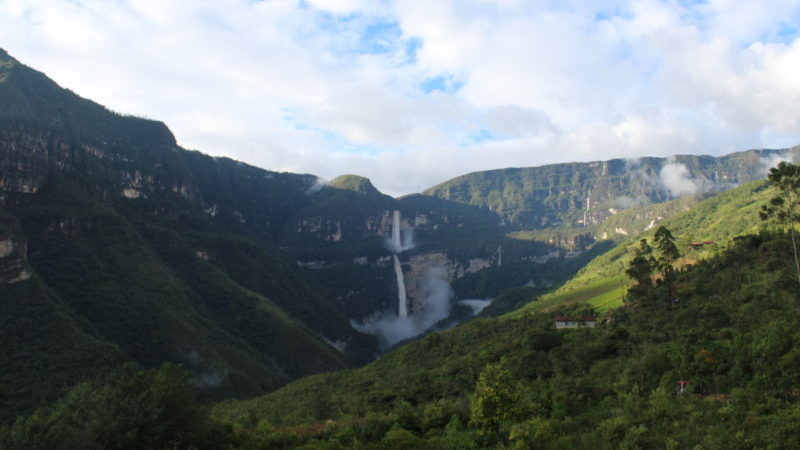
Gocta Falls from afar
There’s little point in us explaining just how magnificent Gocta is – the photos speak for themselves – but rest assured that this spot is a must-visit. Not least because, by some measures, it’s the third highest waterfall in the world. And the 771 meter (2,529 feet) gem is also home to some picturesque hikes and a ton of photo opportunities.
Insider tip on when to visit Kuelap and Gocta from Gary Cohen, Intrepid’s General Manager for South America:
It’s generally quite warm during the day, but can get chilly at night. The best time of year to come here is during the dry season from May to September. A bit of rain isn’t bad though, it gets the Gocta Falls pumping harder!
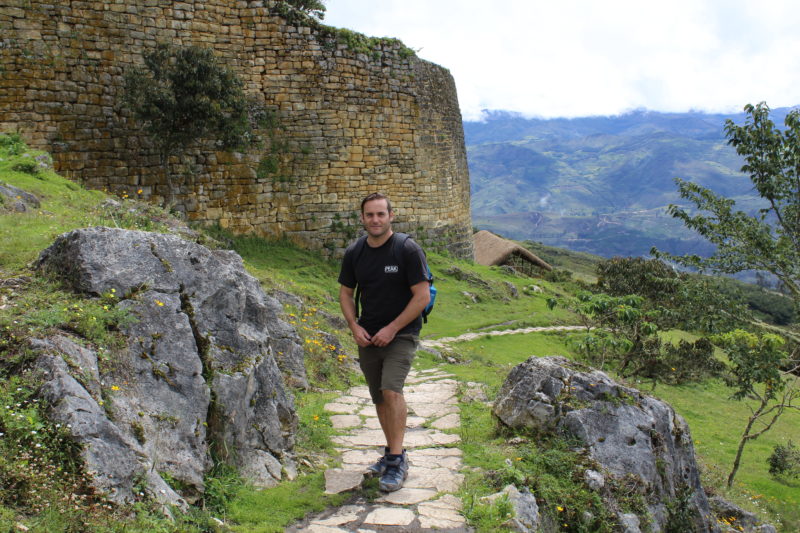
Gary exploring Kuelap
Yerbabuena, Mancora and much more
There’s so much more to Northern Peru. But because we can’t list every cultural, archaeological and natural delight, here are a few more gems:
The Sunday markets of Yerbabuena. The largest market in the entire region, Yerbabuena attracts buyers and sellers from all over to sell produce and animals. It hardly attracts any tourists, making for an authentic and memorable visit.
The historic town of Chachapoyas. Though this town is charming and filled with colonial buildings, it’s its location that really sets it apart. Not only is it the gateway to the walled city of Kuelap, it’s also close to two worthwhile attractions. The first, the Revash Mausoleums, serve as collective tombs for Chachapoya’s dead; the second, Leymebamba Museum, is home to many mummies uncovered at the Laguna de los Condores site.
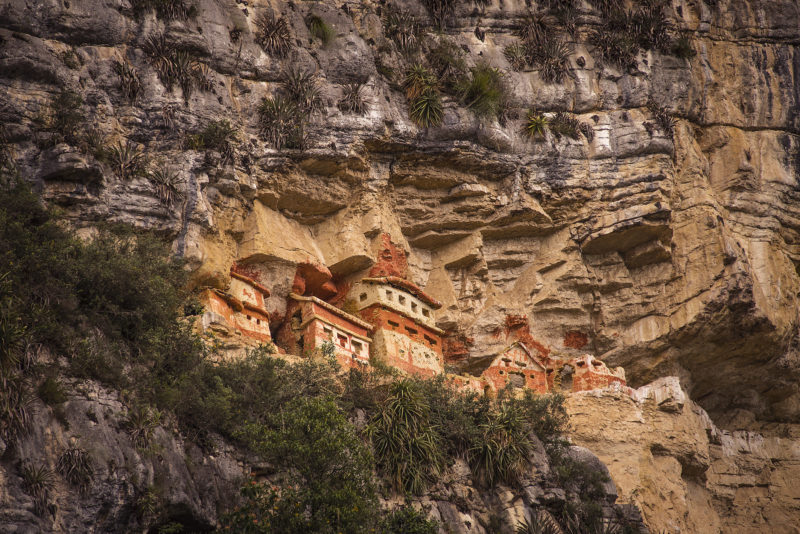
Revash Mausoleums
The surf village of Mancora. Home to some of Peru’s best beaches, sunny Manorca is one of the highlights of the country’s northwest. Its great surf attracts a mix of locals and tourists, but the hot springs, mud baths and lively nightlife are also reasons to visit.
4 benefits of visiting Northern Peru with Intrepid Travel
We know Peru – both north and south – like the back of our hands, but we thought it was worth clarifying exactly how we make our new Northern Peru trip just so unique and memorable:
The expertise of local leaders
The reason we felt so confident saying we know the country like the back of our hands is thanks to the expertise of our wonderful local leaders.
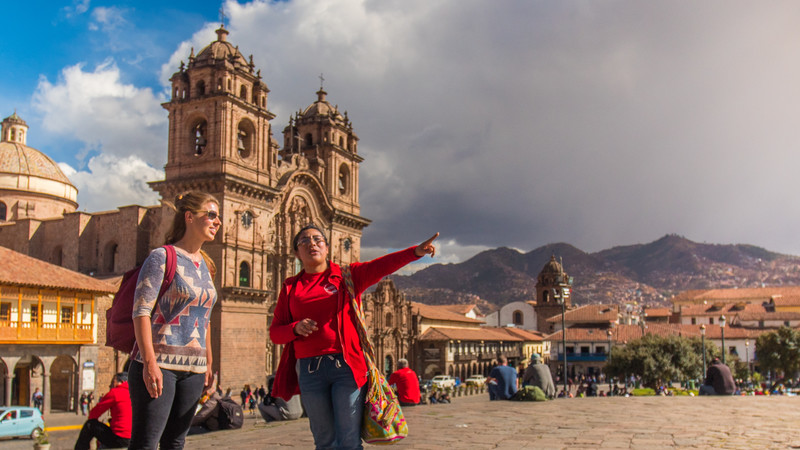
Intrepid leader expertise in Cusco
Our Intrepid tour guides in Peru (all 60 of them!) are all locals. And, more than that, they’re all passionate about showing off their country. So, whether you’re looking for an un-touristy bar in Cusco , a behind-the-scenes insight into Peruvian culture, or some extra encouragement to accomplish that hike, they’ve got your back.
For more info on our local leaders and trips to Peru check out these 10 facts you probably don’t know about Peru .
Insider tips for exploring Lima
As we’ve said, our leaders know all the cool local haunts. Nowhere is this more obvious than in Peru’s capital, Lima. It’s in this city where you begin our Northern Peru trip , and where their tips will prove invaluable upon landing.
To help you acclimatise, we offer an included leader-led orientation walk of Miraflores, a neighbourhood you’ll love. It’s by the sea and offers some of the best parks, shopping and restaurants in the city. Not a bad way to get to grips with the city.
For more incredible experiences in Lima, we recommend our sister company, Urban Adventures. Their day tours are also all led by locals and include coastal biking trips , dinner with a Peruvian family , and a street food and nightlife tour .
Otherworldly accommodation
We handpick all of our accommodation on all our trips, ensuring comfort, safety and an insight into the local culture. But this really is a special one. If you visit Northern Peru with our sister company, Peregrine (trip here ), you stay at a lodge built for the sole purpose of providing views of the awe-inspiring Gocta Falls.
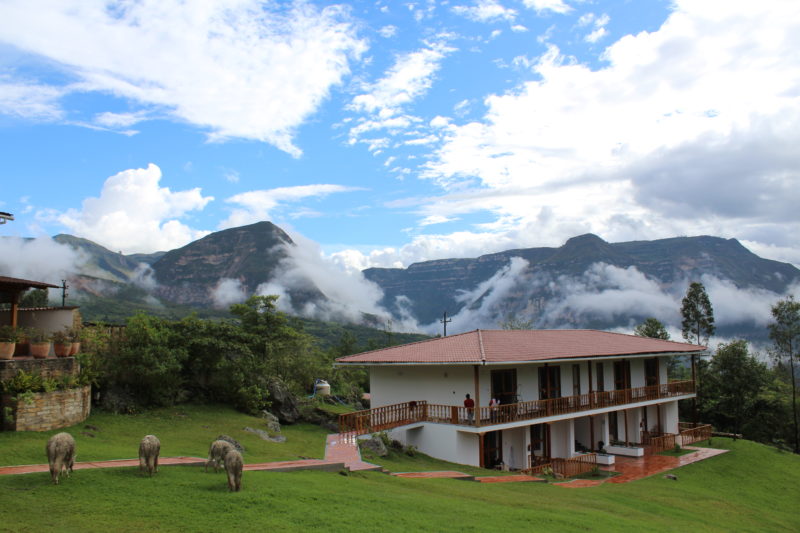
The lodge by Gocta Falls
In other words, it sits nestled in the Andes, oriented towards the waterfall and is surrounded by all the gardens, pools, terraces and llamas (!) you could wish for.
Its outdoor swimming pool isn’t too shabby either.
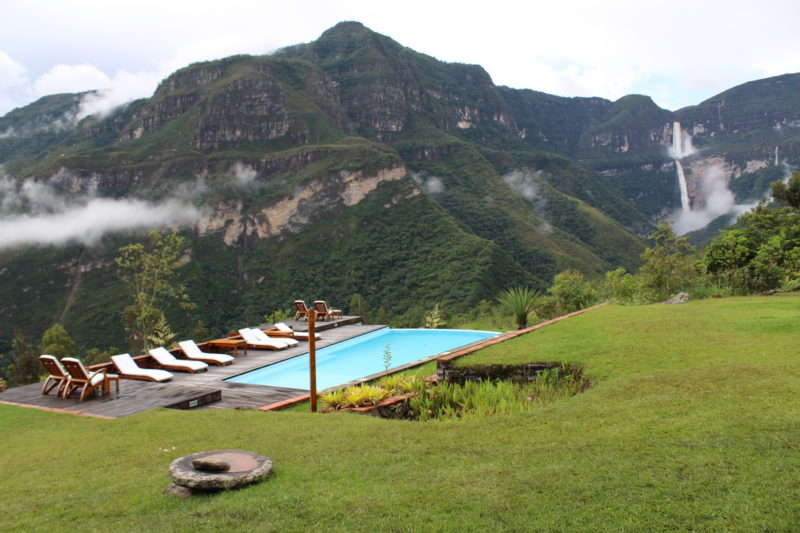
Full-day guided tour of Kuelap
If it wasn’t obvious already, we’re pretty excited about Kuelap. (There aren’t many of us in the fan club YET but Lonely Planet has dubbed it “one of the most significant and impressive pre-Columbian ruins in all of South America”.)
So, to ensure visitors do this wonder justice, we offer a full-day guided tour of the site. It’s pretty spectacular and the local knowledge you’ll receive when there makes it all the more so. Honestly, pay it a visit and you’ll wonder why it receives so few visitors.
The new Machu Picchu has so much to offer the Intrepid explorer.
Northern Peru – beautiful, undiscovered and ripe for adventuring – awaits. Discover it for yourself on our 7-day Northern Peru trip.
Images all c/o Gary Cohen and Intrepid Travel.
Feeling inspired?
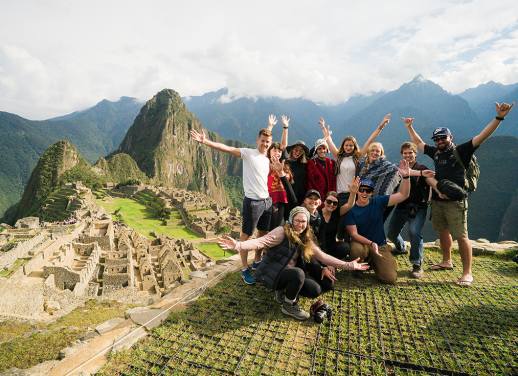
Bex Shapiro
Born in London and based in Toronto, Bex is happiest anywhere she can connect with interesting people over good food. She's passionate about sustainable travel and powerful storytelling, and her favourite cities are New York and Shanghai. She's also the Senior Editorial Manager at Intrepid. Follow her adventures on Twitter and Insta @BexShapiro.
You might also like
Everything you need to know about a night..., 5 places to escape the crowds in italy..., the 7 best places to go on a..., 10 surprising facts about ethiopia, galapagos or madagascar which unique destination should be..., travelling to chile here’s the best time to..., 10 reasons to visit samoa, the 10 antarctica questions you want answered, australia or new zealand where to go on..., 10 epic spots to stop at on your..., small group travel vs coach tours: which is....
- Español
- Português
- Weather and Climate
- Food and Drink
- Latin Culture
- What to do in Peru?
- When to go to Peru?
- What to see in Peru?
- Travel Tips
- Festival and Events
- News about Peru
Northern Peru
- Señor de Sipan
Southern Peru
- Machu Picchu
- Colca Canyon
- Lake Titicaca
- Manu National Park
- All Jungle Tours
- Pisco & Paracas
- Cajamarca Tours
- Chachapoyas Tours
- Lord of Sipan
- Huaraz Tours
- Iquitos Tours
- Mancora Tours
- Trujillo Tours
- Copacabana Tours
- La Paz Tours
- Potosi Tours
- Sucre Tours
- Uyuni Tours
- All Peru Itineraries
- Peru Classic | 14d
- Peru Classic + jungle | 20d
- Peru Classic + north | 20d
- Peru Active + jungle | 20d
- Peru Culture incl. Kuélap | 14d
- Peru & Bolivia | 24d or 28d
- Bolivia in 10 Days
- Bolivia in 14 Days
- Peru & Bolivia 28 Days
- Arequipa highlights 2 days
- Arequipa highlights 3 days
- Arequipa highlights 4 days
- Lima - 2 days
- Lima - 5 days
- Cusco highlights 2 days
- Cusco highlights 3 days
- Cusco highlights 4 or 5 days
- Discount on Treks
Kuélap Fortress
Kuélap fortress, description.

The Kuélap fortress can be seen as one of the largest ancient monuments of Latin America. Kuélap used to be the political center of the Chachapoya civilization from about 900 to 1400 AD. In that era, the city may have had 300,000 inhabitants. Due to the Spanish conquest in the 16th century, the Chachapoya civilization and fortress collapsed and Kuélap was abandoned.
In 2004, Kuélap was placed on the World Monuments Watch List to save the fortress from deterioration. Organisations such as the World Monuments Fund have supported the conservation of the Kuélap fortress.
We will leave from Chachapoyas to visit the arqueological monument of Kuélap . After visiting the arqueological site, we continue our journey by cable car to the fortified citadel of Kuélap for a three hour visit. We will have lunch in the city of Tingo and after that return to Chachapoyas .

Practical Information
Bring with you.
- Rain Jacket or a Poncho
- Hat to protect you from the sun
- Water and Snacks
- Transport to all visited sites
- Tingo-Kuelap cable car ticket
- Professional guide (Spanish/English/French)
- Entrance tickets to all visited sites
Not Included
- Tip for your guide
- Other meals than the mentioned above

Sandboarding and Kayak Piura

Rockclimbing in the Sacred Valley

Bicycle Tours in Lima

Tour Canyon del Sonche

Destinations in Peru: Iquitos
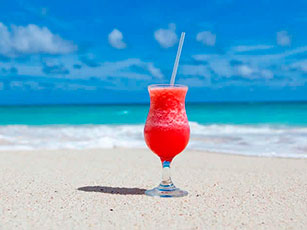
Peru’s 10 Most Beautiful Beaches | Dos Manos Peru

Travel Tips: Visas for Peru
Visit Kuelap: Your Complete Guide to the City in the Sky
2020 Updated Information: Everything you need to know for visiting Kuelap, from your options for getting to Kuelap, to what to expect while you’re there.
For those who are traveling in Peru and craving a lesser discovered adventure, Kuelap is the perfect destination. If you are looking for adventure, history, tradition and amazing landscapes then look no further, Kuelap is the perfect destination. Discover why.
About Kuelap
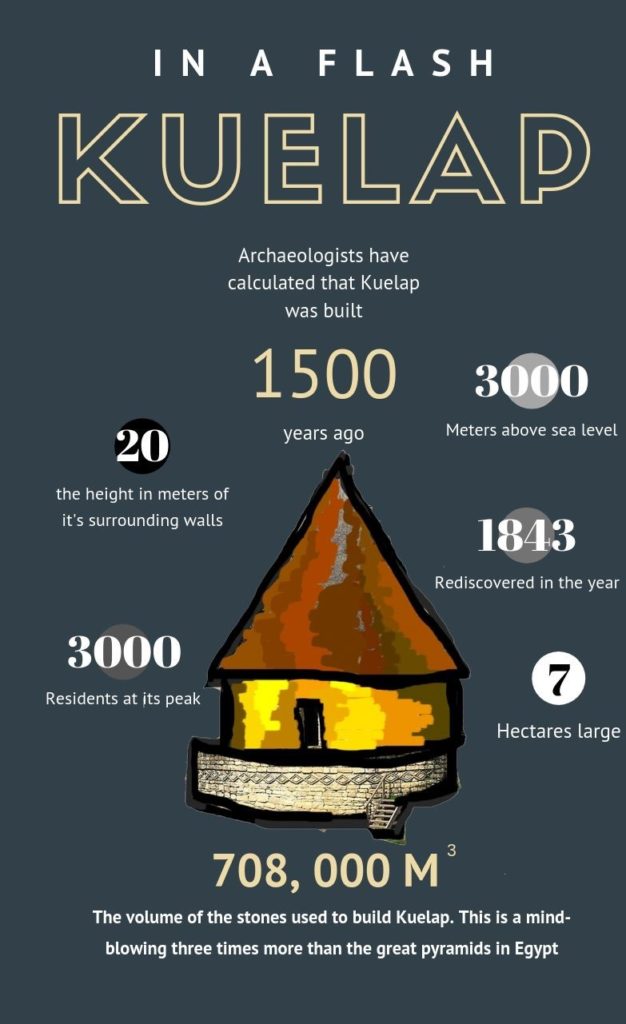
The ancient city of Kuelap is guarded by towers and is found in the Amazonas region of Northern Peru at the peak of a mountain. Kuelap dates back to pre-Inca and the main archaeological site of the Chachapoyas culture and is regularly considered to be the ‘Machu Picchu of the North’, being dubbed as one of the seven wonders of Peru in 2008.
The city and its walls were built somewhere between 500 and 800 AD, meaning that it has been around for 600 to 900 years longer than Machu Picchu . It is made up of more than 400 buildings. One of the main reasons why it was so well preserved was the protection it gained from nature, which becomes obvious when it is seen from above. The journey alone is an adventure worth taking, and the city overlooks the Utcubamba Valley. Time and time again visitors marvel at the views of the cloud forest that surround the area.
For a long time archaeologists believed Kuelap to be a fortress, however, the lack of defensive marks and extensive studies have led experts to believe that in fact, the area has more of a religious significance which is why today it is considered to be a fortified city or as a refuge, with covers for rain and bad weather every 500 meters or so. The site is over a kilometer long and divided into three parts. The largest and most interesting of these three parts is the fortress that lies in the middle, 700 meters long and made with huge stone blocks, each weighing up to 200 kilograms. Visitors are also amazed by the huge walls built to protect the area, measuring an incredible six stories high. As Kuelap was, theoretically, a fortress, the entrances only leave room for one person to enter at a time.
The Discovery of Kuelap
Evidence suggests that the Chachapoyas culture abandoned Kuelap around the time of 1532. After this, the complex was hidden within the cloud forest and fell into ruin. It was rediscovered in 1843 by Juan Crisótstomo Nieto, a judge who had other business in the area. He was so taken by the structure that he wrote a book about it, titled “A Tower of Babel in Peru”. It was only fully documented by the archaeologist Alfredo Narváez in 2007.
Weather in Kuelap
Kuelap has a mild climate, with a maximum temperature of 23°C, and a minimum of 13°C. When planning your travels, remember that Kuelap is located in a cloud forest, so humidity is likely to be high. It’s wise to wear a light waterproof jacket, with a jumper underneath. As always, we also recommend walking boots or sturdy shoes.
Getting to Kuelap
If you want to visit Kuelap by yourself then you can take a car or a combi, which is a sort of group taxi that can carry up to 20 people, to the town of Nuevo Tingo. Nuevo Tingo is around 2 hours from Chachapoyas, and the journey will cost each person 8-10 soles. From there, you can get on a public bus that will take you directly to the cable cars. The cable cars cost 20 soles for a round trip. Alternatively, you can take on the 3-hour hike up to the ruins.
Getting the Kuelap Cable Car
Kuelap’s cable cars are a unique and interesting feature for you to experience on the journey to the fortress. Along with an impressive view of the surrounding forest, riders gain 670 meters of elevation with ease and comfort. The cable cars of Kuelap cover four kilometers of tough, uphill climb in just 20 minutes, and you pass through a layer of cloud, giving you a wonderful view before and after.
The cable cars run every day of the week, between 8 am and 6 pm and the buses from Nuevo Tingo run to the departure platform every ten minutes. There are no restaurants or shops in Kuelap so remember to take a snack and some water with you.
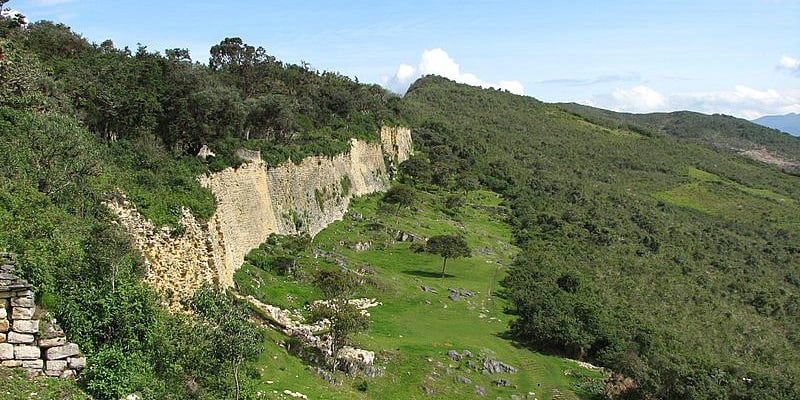
Walking to Kuelap
Many people like to walk to archaeological sites in Peru, and it’s not hard to figure out why. When exploring sites that were made way before the motor, some believe that the hike there gives you a more “real” experience of the place. After all, hikes to Machu Picchu are endlessly popular, and for good reason. There are two or three different ways that you can choose, but the most popular sets off from the town of Tingo located at the bottom of the hill. The walk is heavily signposted and directions are clear, so you are unlikely to get lost. If you are traveling from Chachapoyas then you will need to get a collectivo to the town of Tingo.
The walk is steep and challenging, with 5 points of rest on the way up. You will then arrive at one of Kuelap’s minor entrances, where you will be charged the 20 soles entry fee. Make sure that you have the right change with you, or risk walking an extra two kilometers round to the main entrance.
Be aware that the walk up is in direct sunlight, so if it is a hot day then you will get dehydrated much faster. Plan accordingly, and pack a sunhat, sunscreen and extra water. There are no shops on the way up, so make sure that you have everything you need before you leave the town.
Taking a Tour of Kuelap
You can take a tour of Kuelap that leaves from Chachapoyas in the morning. This tour will cover all of your transport and the tour guide, usually costing around 120 soles per person, in groups of around 15 people. You can book your tour in advance on Find Local Trips .
The Kuelap Massacre
The Chachapoyas culture had a very strict funeral ritual that was routinely followed. However, the remains of men of all ages were found outside one of the houses. Because the usual funeral rituals were not followed, it is heavily suggested that these bodies were the result of a massacre. Historians’ best guess is that this is the result of a conflict between local families. This is because there were no signs of swords or weapons that would suggest it was the work of either the Incas or the Spaniards.
Entering Kuelap
There are three main entrance points to the site. Entrance number one was previously used for the delivery of food and water, and you can even see the hoof marks of the llamas that were used for this in the rocks. The second entry was used by the villagers returning from the fields and leads to a cemetery just outside of the citadel. The main entrance used by the people of the Chachapoyas culture is actually closed to the public for security reasons, as it is at risk of collapsing, although restoration work is underway.
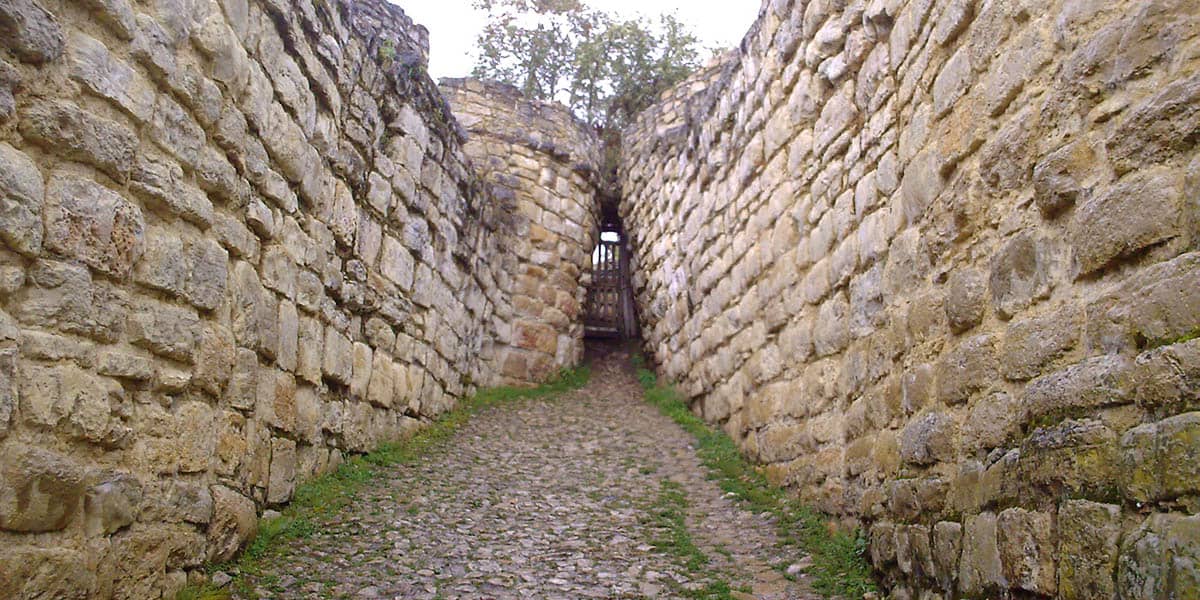
The Round Houses of Kuelap
Once inside, you are immediately met with the area that people lived in, and where most of the round houses are located. These round houses are an exclusive feature of the Chachapoyas culture. They are mostly in ruins; previously a replica was built to help visitors to picture the town, but after much debate, it was torn down in order to avoid unintentional distortion of history. This is in keeping with the Peruvian government’s stance on not rebuilding historic monuments.
There were approximately 420 houses on this first level. In each house lived a large family of about 8 people. In these houses, you can find places to make a fire, traces of large stones used for grinding, and at least two or three graves. This is a typical feature of the Chachapoyas culture.
The atmosphere here is mystical as this part of the citadel was not cleared. As a result, it is still covered with vegetation of all kinds, including wild orchids. You can easily imagine how the people of the Chachapoyas culture lived here.
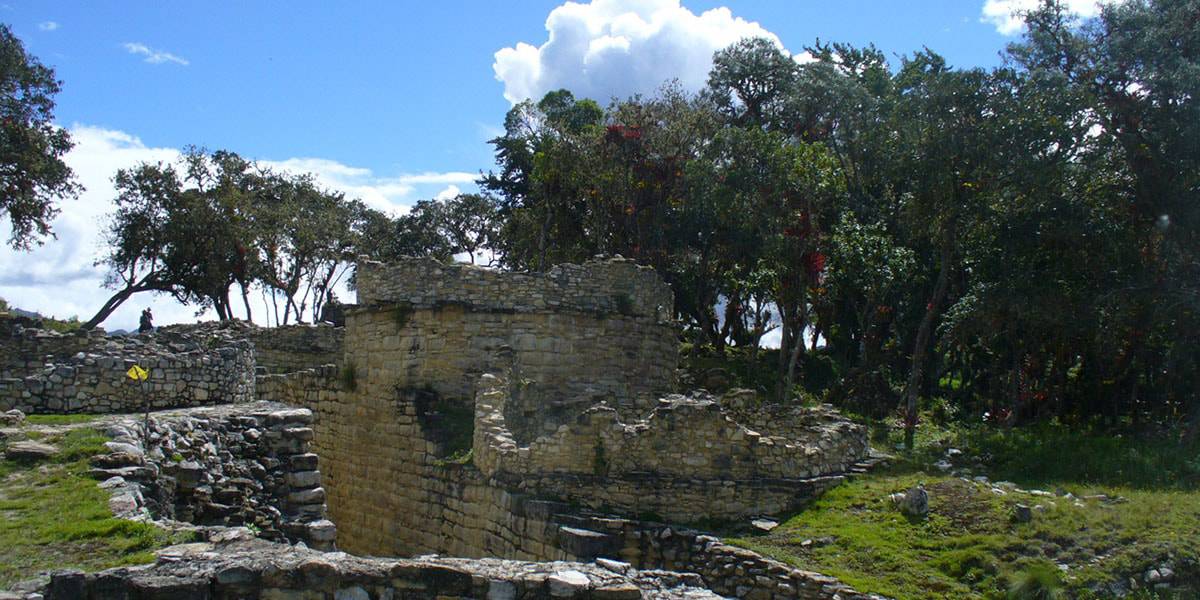
The Inkwell (or Templo Mayor)
One of the most important structures of the site is the Inkwell, otherwise known as the Templo Mayor. A cylindrical monument can be found, known as the “Tintero”. This is a highly religious place, and inside remains of human bones can be found. This implies it was the location used for human sacrifice. Bones have been found here which date back to before 0 AD, meaning that Chachapoyas culture is older than previously thought.
The Second Level of Kuelap
The second level of Kuelap is the area that the most honorable and religious people in the city lived. You can find a watchtower named El Torreón and a castle. The usage of the castle is up for debate- some argue that it was used as an operations room, others believe that it was the area for artificial deformation of people, specifically skulls, but other surgeries as well.
Interestingly, there is also some Inca remains in this pre-Inca site. A total of four buildings dating from the Inca era can be found.
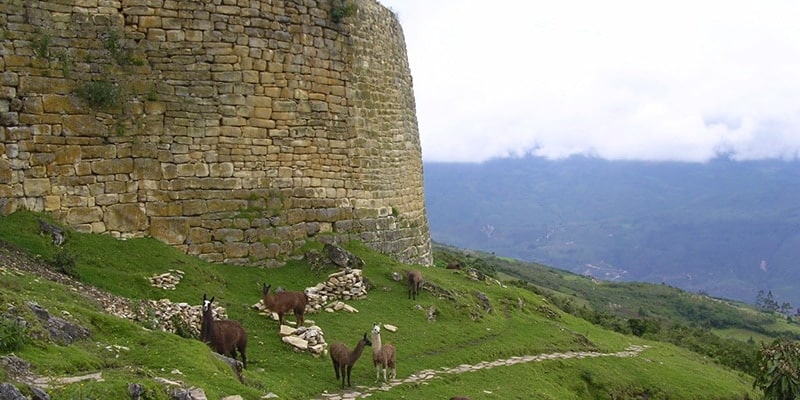
Don’t miss Kuelap
Kuelap is becoming more and more popular each year. There are huge ruins, incredible landscapes, beautiful wildlife and history in every rock. Discover for yourself: Kuelap, the city in the clouds.
YOU MAY LIKE

Lima to Machu Picchu – Agencies DON’T want you to read this!

#1 Rated Day Trips From Lima To Unforgettable Destinations

Everything You Need to Know to Avoid the Typical Tourist Mistakes At Machu Picchu

What NOT To Do When Visiting Rainbow Mountain

Spend 50% less and see 100% more in Peru

Machu Picchu Tickets – All You Need To Know!

These Hidden Destinations Just Outside Of Lima Will Blow Your Mind!

Peru – How to Avoid Being a Typical Tourist

OFFICIAL: This Company Was Voted The Best Way To Get Around Peru

Peruvian Travel Secrets That Only The Locals Know
You must be logged in to post a comment.

Peru Traces Travel & Tours
- (+51) 998 090 000
- E-mail: [email protected]
- (+51) 998 889 087
- BEST PERU TOURS Most Visited Peru Tours
- ADVENTURE IN CUSCO
- ADVENTURE IN HUARAZ
- ADVENTURE IN CHACHAPOYAS
- COMFORTABLE AMAZON CRUISES
- LUXURY AMAZON RIVER CRUISES
- TOURS MANU NATIONAL PARK
- Tambopata Tours
- ECO TOURS IN THE AMAZON RIVER
- LUXURY PERU TOURS
- CULINARY TOURS PERU
- MYSTICISM TOURS & INCA WEDDING
- SPECIAL DISCOUNT TOURS
- ADD ON TOURS PERU
- GRAND SOUTH AMERICA TOUR
- BEST BOLIVIA TOURS
- ADD-ON TOURS
- CONTACT A SPECIALIST
CHACHAPOYAS TOURS

AMAZONAS: LAND OF CHACHAPOYAS CULTURE
6 DAYS: CHACHAPOYAS, KUELAP PRE INCA CITADEL, KARAJIA SARCOPHAGI, GOCTA WATERFALL, REVASH MAUSOLEUM, LEYMEBAMBA MUSEUM
Come and tour or trek in Chachapoyas , an area of magnificent landscapes, diverse flora and fauna and incredible archaeological remains. Off the beaten track and away from the crowds. Chachapoyas in northern Peru: Kuelap , Gocta waterfall, Karajia, Revash and Leymebamba – a rich cultural experience.
See below a detail of the places we will visit:
Chachapoyas
Chachapoyas (founded as San Juan de la Frontera de los Chachapoyas , on September 5, 1538) is a city located in the mountains of the department of Amazonas Peru, capital of the province of Chachapoyas and the department of Amazonas. It stands on the eastern slope of the Andes mountain range, in a plain of the Utcubamba R iver basin, a tributary of the Marañón R iver . The city has a population of 32,026 inhabitants according to data from the 2017 National Census.
The city is made up of the oldest neighborhoods such as La Laguna, Yance, Santo Domingo, Luya Urco, Higos Urco; as well as popular urbanizations: Pedro Castro Alva, San Carlos de Murcia, Señor de los Milagros, October 16, etc.
The S arcophagi of Karajia
The Sarcófagos de Karajía, or Carajía, are a set of sarcophagi or coffins according to the funerary tradition of the Chachapoyas in Peru, up to 2.50 m high with human shapes. They were found in the Karajía ravine in the Luya district of the Department of Amazonas in 1985 by the Peruvian archaeologist Federico Kauffmann Doig thanks to the references provided by Carlos Torres Mas.
Gocta W aterfall
The Gocta waterfall, known locally as La Chorrera, is a waterfall that is located in the vicinity of the Peruvian villages of San Pablo, Cocachimba and La Coca, district of Valera, province of Bongará, department of Amazonas in northeastern Peru.
In March 2006, a group of explorers led by the German Stefan Ziemendorff, decided to take topographic measurements of the waterfall and discovered that its total height is 771 m1 (in two stages), which places it in the place number 17 in the world list of waterfalls and as the third highest waterfall in Peru, being the Tres Hermanas waterfall (914 m), in Junín) in first place, and the Yumbilla waterfall (895.4 m), in Amazonas, in second place.
The Gocta waterfall is visited by many tourists. There are several routes that can be taken to get to the waterfall, the main one is starting the journey from the city of Chachapoyas to the town of Cocachimba , there you can find all the basic services (food, lodging, etc.). , then walk approximately two and a half hours; y ou can also do the tour on horseback.

Kuelap adventure tour
Kuélap, or Cuélap, is an important pre-Inca archaeological site located in the northeastern Andes of Peru, in the Province of Luya, it was built by the Chachapoyas culture.
It forms a large stone architectural complex characterized by its monumental condition, with a large artificial platform, oriented from south to north, sitting on the calcareous rock ridge at the top of Cerro Barreta (at 3000 meters above sea level). The platform extends for almost 600 meters and its perimeter is a wall that at some points reaches 19 meters high.
It is estimated that its construction should have begun around the 11th century, coinciding with the flowering period of the Chachapoyas culture, and its occupation must have culminated in the middle of the 16th century. Its colossal walls and its complex interior architecture are evidence of its function as a well-organized population complex, which includes administrative, religious, ceremonial spaces and permanent residence spaces.
The archaeological complex of Kuélap is located in the Department of Amazonas , Luya province. It is accessed from the Leimebamba District road, leaving the paved road at the height of Nuevo Tingo, near the bank of the Utcubamba River, where the road continues along a carriageway uphill, until it reaches a plain in the vicinity of the monument, where there is a path that leads directly to the Citadel. It is also possible Access by a steep path that starts from the town of El Tingo, near the Utcubamba riverbank, with a distance of 8.9 kilometers and a drop of 1200 meters. From March 2, 2017, the complex can be accessed with the use of the cable cars.
Mausoleums of Revash
The Revash mausoleums are a necropolis belonging to the Chachapoyas Culture. They are located in the Santo Tomás district, Luya province, Amazonas department.
They were collective tombs that occupy natural caves or excavated in the rocky wall of an imposing ravine.
Described by the Peruvian archaeologist Federico Kauffman Doig , who maintains that the mausoleums are replicas of the houses where the people of the area lived.
Painted in red and cream, some have gabled roofs, without being necessary, because in the event of possible rains the hill served as protection. Some others have two levels and have T-shaped, cross or square windows. Part of the rocks are painted red with circles, flames, and other magical symbols.
Located at 2800 meters above sea level, it takes about 20 min. by car from Hierba Buena to reach the beginning of the trail that takes an hour and a half uphill walking
Leymebamba Museum or Mallqui Center
It was built from the need to have a suitable place for the conservation of mummies and archaeological materials recovered in the Laguna de los Cóndores in 1997. This work was carried out by the Mallqui Center with contributions from the international community from Austria, Finland , Italy and the United States, as well as important contributions from the Institute for Bioarcheology, the von Hagen family and the Discovery Channel.
The local community contributed with their work on sites and with construction materials. The town of Leymebamba is the owner of the museum and is represented by a Civil Association. Administrative and professional work in the museum is carried out by the Mallqui Center . It was inaugurated in June of the year 2000 with the presence of the Austrian Minister of Education, Dr. Elisabeth Gehrer.
The design corresponds to the architects Jorge Burga and Rosana Correa, while the museography is the product of the collaboration of Rodolfo Vera and Sonia Guillén. It was built using local architectural techniques such as mud with wooden and tile roofs, complemented with modern technical resources to meet the needs of conservation and exhibition of archaeological materials.
Most of the cultural remains that are exposed correspond to the Chachapoya culture and the time of Inca rule in the area. It also has a room dedicated to the traditional continuity in the region.
Starting from the museum, the Mallqui Center maintains a line of bioarchaeological research, management of archaeological collections, as well as educational programs, tourism, and the recovery and protection of natural resources.
CHOOSE YOUR L A N G U A G E

- Jr. Domingo Orue 450 Miraflores, Lima 18 - PERU
© 2022 Peru Traces Travel & Tours. All rights reserved.
- COMPLAINTS BOOK

Tour to kuelap
by NORTE | Mar 7, 2021 | Chachapoyas , Full days , Green & Wildlife Tours

Tour to kuelap: “Power on the clouds”
This morning, get immersed in the culture and history of the Chachapoyan people at Kuelap, a fortified city made up of more than 400 circular buildings and complexes. Ride a cable car up to the site, thought to have been an important cultural center for these pre-Inca “Cloud Warriors.” Learn about coffee harvesting at a sustainable coffee farm before tasting coffee from the area.
Tours to Kuelap take a full day, starting in the morning at around 8 am and lasting about 8 hours, depending on where you are staying.
The recent installation of a cable car system has greatly improved the ease of access. It carries visitors from the town of Nuevo Tingo to an area that is a 30-minute up hill walk from the archaeological site. Horses are available to hire for the walk from the cable car station to the entrance of Kuelap if necessary.
The Kuelap cable car system stretches about 14,435 feet (4,400 m) up the mountainside, taking about 20 minutes each way. This new improvement cuts out 90 additional minutes driving on a winding dirt road. Keep in mind that the cable car is open Tuesdays through Sundays from 8 AM to 5 PM. If traveling to Kuelap on a Monday, additional driving time should be considered.
ADDITIONAL INFORMATION INCLUDE:
- Wear light clothing and comfortable shoes.
- Bring water, sunglasses, camera, sunscreen.
- In rainy season bring a poncho or waterproof jacket.
- Transportation, English tour guide, Lunch and Entrances Fees are included..

This is my dream , I want this tour…to Kuelap
- Pre Incas Sites
- Green & Wildlife Tours
- Tours Packages
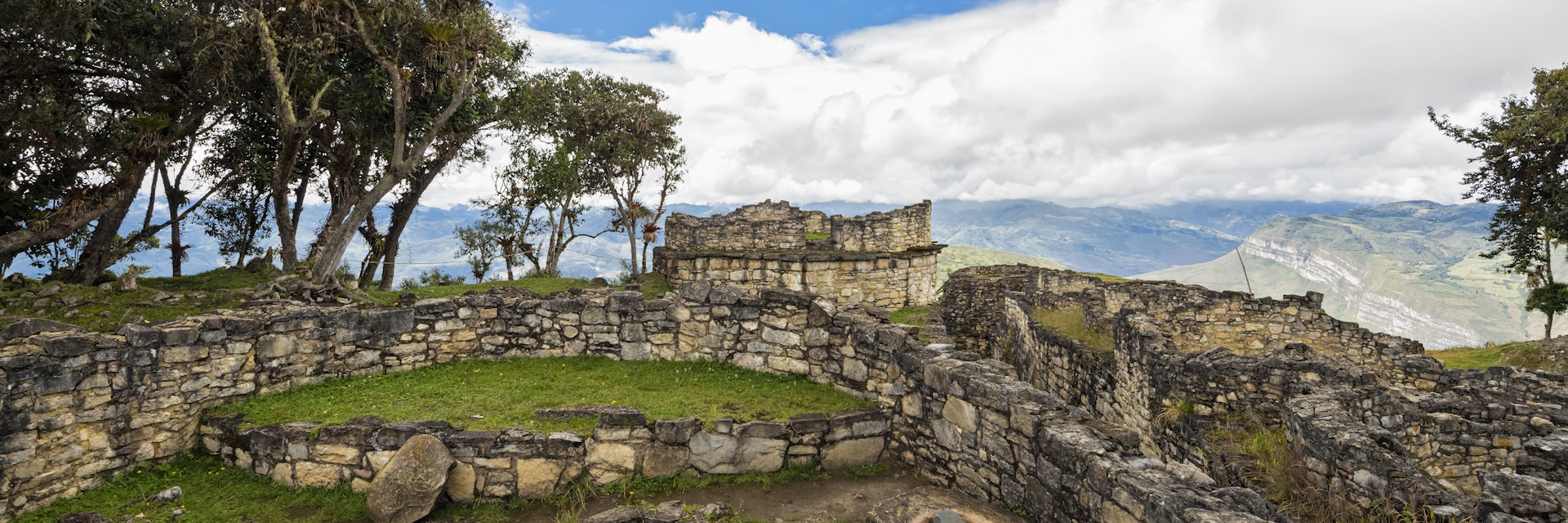
©Westend61/Getty Images
Top choice in Kuélap
Travelers have their heads literally in the clouds when visiting the walled jungle fortress Kuélap in the northern highlands of Peru – the gateway to the Amazonas region. Overlooking the lush Utcubamba Valley, situated at 3000m (9842ft) above sea level, this remote pre-Inca site is spread over 15 acres, making it one of the largest stone ruins in the Americas. Built by the indigenous Chachapoyas, Kuélap includes over 400 circular buildings (many well-preserved) that can be reached by foot or cable car .
Dubbed the "Machu Picchu of the North," this lofty piece of history has yet to become a major tourism draw as the location is slightly off-the-beaten-path. The spectacular history and views of the cloud forest are reason enough however to take on the adventure of getting there.

History of Kuélap
A grandiose project, Kuélap was built by the Chachapoyas people (meaning “Cloud Warriors”) as early as the 7th century, a challenge that would continue on for at least another 400 years. The finished result is a near-mile-long stone complex divided into three sections, surrounded by walls (some reaching over 18m/60ft high) and with three narrow entrance points that would have forced intruders to slow down and enter in single file. Kuélap played witness to the flourishing Chachapoya culture and its purpose likely evolved with the years – fortress, refuge, strategic defense point and high-altitude city are among the site’s likely roles.
The Chachapoyas enjoyed a few hundred years of peace and development until another culture in Peru began expanding across the Andes and along the coast of Peru. According to archaeological evidence and chroniclers of the time, the Incas chased the Chachapoyas out of their sky-high fortress towards the end of the 15th century and built a few of their own structures on the premises; a century later they too would suffer a loss when the Spanish violently colonized the pre-Columbian empire.
Though the Incas were hoping to completely wipe out the Chachapoyas people, their legacy lives on in the genetic traces of indigenous communities that populate the modern Chachapoyas city.
Ultimately abandoned, Kuélap was on the path to ruin as local fauna began to invade the area and thick cloud forest blanketed it from the common explorer. For better or worse, a local judge on a field visit to the area happened upon the stone complex in the 1840s, though no records show if damage, theft or otherwise was carried out. Not until 1979 did Peru’s Ministry of Culture take notice and implement plans to protect and conserve a piece of its history.
Today the once-forgotten stronghold is on the Unesco World Heritage Site Tentative List and the recent (2017) implementation of on-site cable cars is just one effort to make Kuélap more appealing and accessible to tourists.

Top things to see at Kuélap
Only a third of Kuelap has actually been excavated and yet what is visible is quite striking and telling of the pre-Columbian Chachapoya culture.
Shielded by a colossal stone wall, the center of Kuelap is scattered with hundreds of low circular walls – the remnants of dwellings that were once covered by soaring thatched roofs. The round shapes are enough to make the Chachapoya culture unique, considering most ancient Andean cultures used straight lines in their designs. Epiphytes and orchids lure hummingbirds, which in turn guide visitors along the nearly 610-meter (2000ft) long site, passing rhomboid friezes and zoomorphic reliefs along the way.
Keeping a balance on the south and north ends, Kuélap is guarded by two towering structures. On the southwestern end of the site stands the Main Temple, also referred to as El Tintero (Inkpot). Fashioned in the shape of a large inverted cone, this enigmatic structure likely served religious or ceremonial purposes – archaeologists have found an underground chamber housing the remains of animal sacrifices, as well as graves and llama skeletons in the surrounding area. Meanwhile its height of 5.5m (18ft) has led others to speculate it was used as a solar observatory.
On the northwest is the 7-meter (23ft) tall Torreón, a tower perhaps used as a watchtower or for defensive purposes due to findings of stone weapons.

When to visit
Located in northern Peru , where the Andes meet the Amazon , Kuelap is no stranger to sudden spouts of rain. The ideal time of year to visit Kuélap is between April and October, the so-called dry season (though rain in this region can be unpredictable any time of year). Temperatures will be slightly cooler, but the sun will likely be shining upon the high-altitude site.
Unlike Machu Picchu , Kuélap can be visited all year round. The main disadvantage of visiting between November and March is the high probability of rainfall, making any length of the hike much more difficult and the numerous changes in transportation required all the more uncomfortable.
Keep in mind that the site attracts a fair amount of local visitors on the weekends and holidays, so aim for a mid-week visit early in the morning.
It is recommended to wear light layers as well as to bring a sun hat, rain jacket, sunscreen and bug repellant.

How do I get there?
Far from major urban hubs, Kuélap is relatively isolated compared to its younger and more famous cousin, Machu Picchu.
The fastest way to get to Kuelap is by flying from Lima to the high jungle city Jaen , a 1.5-hour flight. There are typically two direct flights offered daily by Latam airlines, and it is recommended to take the early flight as, from Jaen, the city of Chachapoyas is a 4-hour drive by car or bus. Once in Chachapoyas take a taxi or colectivo (shared public transport) to Nuevo Tingo (about 1 hour away) to purchase lift tickets. Hop on a cable car for a scenic 20-minute ride that ascends towards Kuélap. After disembarking, travelers will have to walk 30 minutes to arrive at the site entrance.
In total, it takes about 8 hours of hopping on and off transportation to arrive at Kuélap (depending on bus or taxi availability and road conditions), making the journey of getting there an adventure in itself. There are plenty of small inns and hostels in Chachapoyas should travelers forgo the rush and enjoy a bit of rest before jumping in the car again to head to Nuevo Tingo.
Alternatively, those looking to stretch their legs can skip the cable cars and, from Tingo Viejo, embark on a 9km (5.6mi) hike through the cloud forest along the Camino Herradura . It takes about 3-4 hours to ascend the craggy mountainside and, though trails are well-marked, local guides can be hired in Chachapoyas city.
Tickets and information
Once a site well off the beaten path, Kuélap is inching its way to popularity thanks to the cable cars and direct flights to Jaen – neither of which were transportation options a decade ago. However, the low fees for arrival and entrance are an indication of how little tourism the impressive site continues to receive.
Purchase of tickets for the cable car and site entrance is only available on site. Round-trip tickets for the cable car ride must be paid in cash (Peruvian soles only) and cost S/21.70 per person (regardless of age). The cable lift system operates Tuesday through Sunday, 8am-4:30pm. Keep in mind that while the cable cars do not operate on Mondays there are buses that can transport travelers from Nuevo Tingo towards the site entrance.
Entrance to Kuélap costs S/30 for adults, S/15 for seniors and just S/2 for children 12 years or younger. Visitors should expect to spend at least 2 hours perusing the site. Hiring a local guide is strongly recommended to get the most out of the trip.
Suggest an edit to this attraction
Lonely Planet's must-see attractions
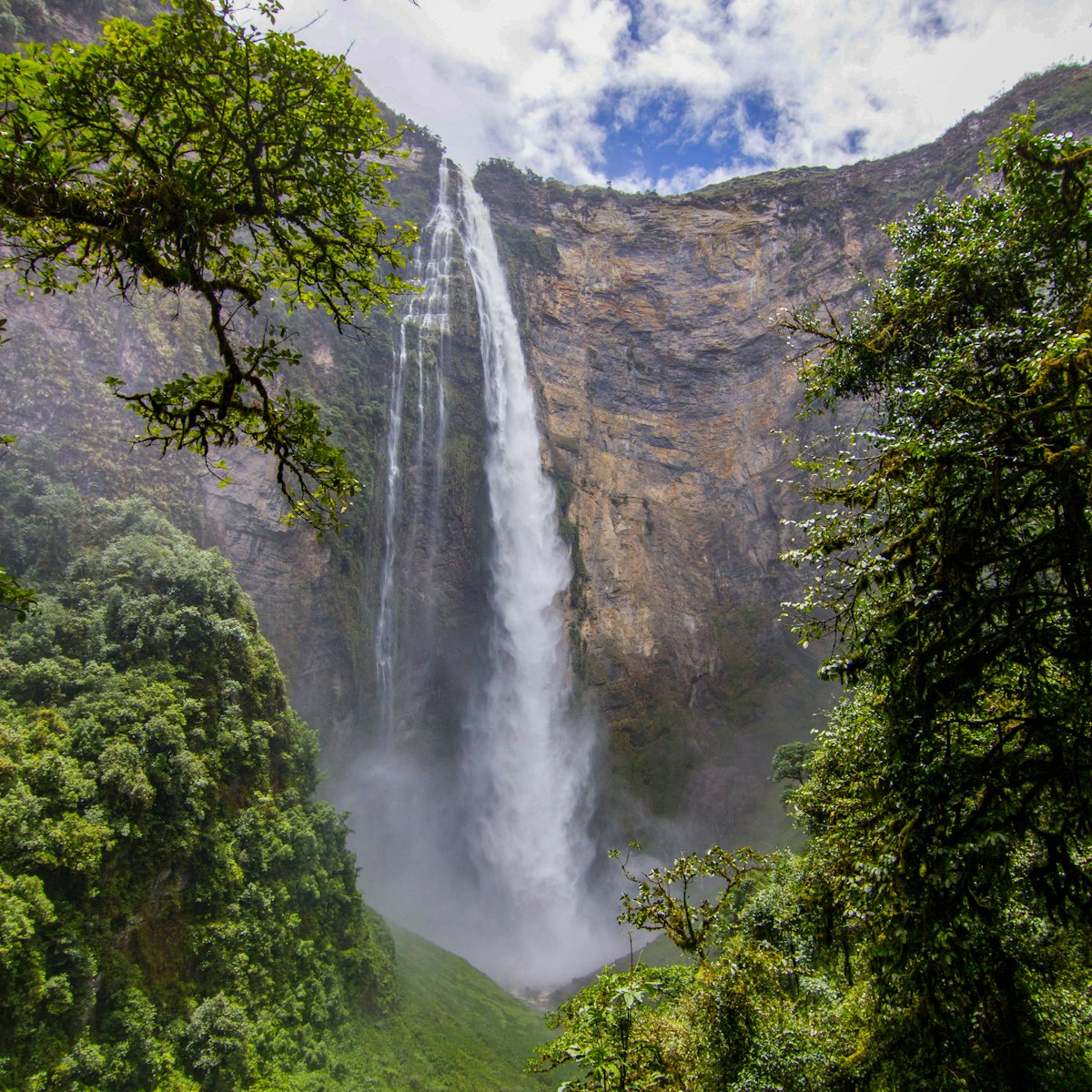
Catarata de Gocta
27.28 MILES
This 771m waterfall somehow escaped the notice of the Peruvian government, international explorers and prying satellite images until 2002, when German…

Museo Leimebamba
22.76 MILES
The mummies found at Laguna de los Cóndores are housed in the Museo Leimebamba, 5km south of town. The museum is owned by the local community and located…

Gran Vilaya
13.25 MILES
The name Gran Vilaya refers to the bountiful valleys that spread out west of Chachapoyas, reaching toward the rushing Río Marañón. Abutting the humid…

This historic site protects several brightly colored funerary buildings tucked into limestone cliff ledges high above a valley near the town of Santo…

This largely unexcavated archaeological site dates from around AD 1100 and is located 17km south of Chachapoyas near the village of Levanto. A visit here…

19.22 MILES
This extraordinary funerary site hosts six sarcophagi perched high up a sheer cliff face. Each long-faced tomb is constructed from wood, clay and straw…

19.17 MILES
The most captivating of the many ancient ruins strewn around Leimebamba, La Congona is definitely worth the three-hour hike needed to get here. The flora…

17.27 MILES
The tiny and agreeably unkempt village of Huancas (pronounced like the English ‘wankers’!) has a small artisan community making clay pots the old…
Nearby Kuélap attractions
3 . Gran Vilaya
This whitewashed church, officially known as the Catedral San Juan Bautista, sits on the Plaza de Armas. Its heavy black wooden doors rarely seem to open…
5 . Instituto Nacional de Cultura Museo
13.48 MILES
This small museum on the Plaza de Armas houses mummies found throughout the region, plus ceramics from several pre-Columbian periods and one of the…
6 . Mirador Luya Urco
13.56 MILES
A 10-minute stroll northwest along Salamanca brings you to this modest lookout with a city panorama.
7 . Huancas
8 . Mirador Cañón del Sonche
17.44 MILES
The joy of this steep-sided canyon that cuts like a deep gash through the Northern Highlands is that you’re barely aware it’s there until you are…
Username or E-Mail
Forget Password?
Do not have an account?
Already a member.
- About Homestays
- Peru Cultural Events Calendar
- All Peru Packages
- Cusco Trekking
- Cusco Tours
- Machu Picchu
Chachapoyas Kuelap Tour, Gocta Falls 6 Days/5 Nights
Adding item to wishlist requires an account, already a member.
Username or E-mail
Don't have an account? Create one.
Join Ayni Peru for an extraordinary Chachapoyas, Gocta Falls, and Kuelap tour! Chachapoyas, located in the remote jungle of northern Peru, is quickly becoming a top Peruvian destination. With stunning pre-Hispanic ruins such as Kuelap, gorgeous cloud forest scenery, and Gocta Falls, one of the tallest waterfalls in the world, a Chachapoyas tour is an unforgettable experience.
Our time in Chachapoyas begins with a stunning Kuelap tour, often referred to as the “Machu Picchu of the North”. In contrast to Machu Picchu , the enormous citadel was constructed by the Chachapoyas people. It´s unique construction and incredible views are a fascinating contrast with Inca ruins largely found in southern Peru.
From there, take a few days to enjoy the breathtaking Gocta Falls, Revash ruins, and incredibly beautiful scenery. Chachapoyas is a top destination for bird watching, adventure activities, and archaeological travel. Our itineraries are highly flexible, including extensions to Machu Picchu and many other Peruvian highlights!
- Visit Peru’s best museums to begin your adventure into Peruvian history.
- Tour Kuelap, the incredible pre-Hispanic fortress left behind by the Chachapoyas civilization.
- Marvel at Gocta Falls, among the tallest in the world, set in the remote Peruvian cloud forest
- Enjoy beatiful and varied natural scenery; Chacapoyas is a world-calss bird watching destination!
- Choose from a wide range of optional tours and activities to customize your experience
Tour Details
Duration : 6 days/5 nights Departure Dates : Any day you would like! Please contact us for reservation information and custom tour options. Pricing : Please contact us for a custom quote.

Day 1 : Lima to Chachapoyas
This morning, board a short flight from Lima to Jaen. Jaen is located in northern Peru´s cloud forest, and the closest airport to Chachapoyas with daily departures. From there, transfer to Gocta Lodge, a beautiful property with views of the incredible Gocta Falls. You´ll have the evening free to relax and prepare for tomorrow´s adventure!
Day 2 : Revash and Kuelap
After breakfast, depart with your guide for Revash, an astounding complex of mausoleums and cave paintings. Revash was constructed by the Chachapoyas people as a final resting place for the dead. With separate areas for royalty and commoners, the impressive “houses” created to house the mummified dead are truly impressive. Located high above in exposed caves on a cliff face, we´ll observe the ruins and wonder at the beliefs of the mysterious Chachapoyas culture. After a break for lunch, continue to the famous Kuelap fortress. Kuelap is constructed high above dramatic canyons, often drawing comparison to Machu Picchu. While both are incredible, pre-Hispanic constructions, Kuelap is significantly older that Machu Picchu, with distinct symbolism, and construction techniques. Late afternoon to early evening return to Gocta Lodge for a nice dinner.
Day 3 : Sonche Canyon
After time to sleep in and a later breakfast, depart with your guide for Sonche Canyon. This is the deepest canyon in the area, with amazing panoramic views. Enjoy a picnic lunch, with a mid-afternoon return to Gocta Lodge. Dinner will be served in the lodge.
Day 4 : Leymebamba
This morning depart with your guide to the town of Leymebamba. Explore the amazing local museum, which features an impressive collection of mummies collected from nearby areas. In the afternoon, you´ll have the option of participating in a short birdwatching tour, or returning to your lodge for the evening.
Day 5 : Gocta Falls
Today you´ll have the option to hike tothe gorgeous Gocta Falls, considered the 3rd tallest waterfall in the world. The hike lasts approximately half a day, and can be completed in either the morning or afternoon. If you prefer, enjoy the day on the Gocta Lodge property.
Day 6 : Chachapoyas- Lima
At the appropriate time, transfer to the Jaen airport for your return flight to Lima. Upon arrival, meet the connecting flight to your next South America destination or international flight home.
PRICING & INCLUSIONS
Price includes.
- Professional and experienced English-speaking guide
- All activities, tours, and entrances
- All required ground transportation
- All domestic flights
- Hotel rooms (based on double occupancy in 3 star hotels)
Price Excludes
- International flights
- Traveler`s insurance
- Discretionary expenses such as gratuities, snacks, alcoholic beverages, etc.
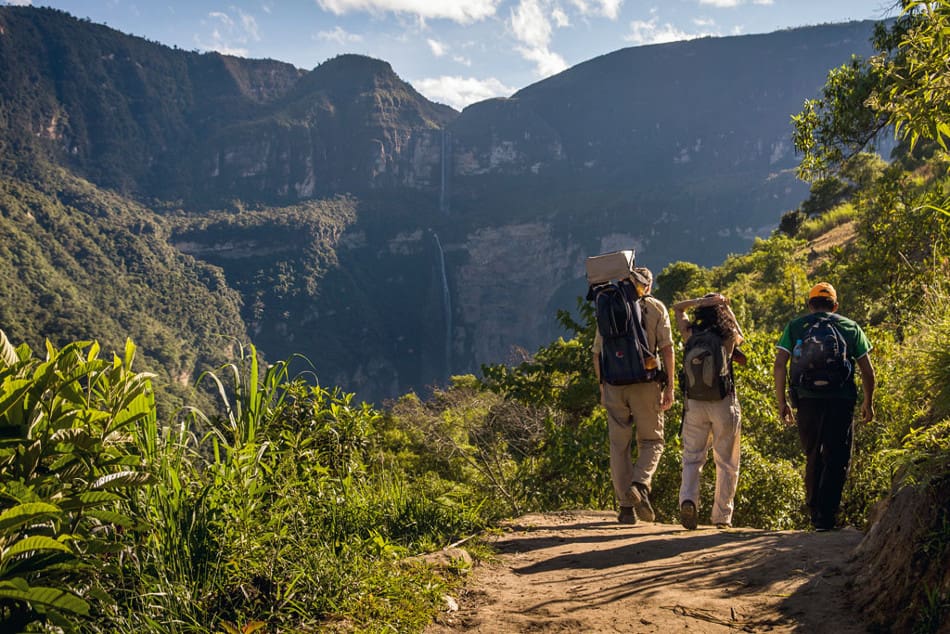
Related Tours
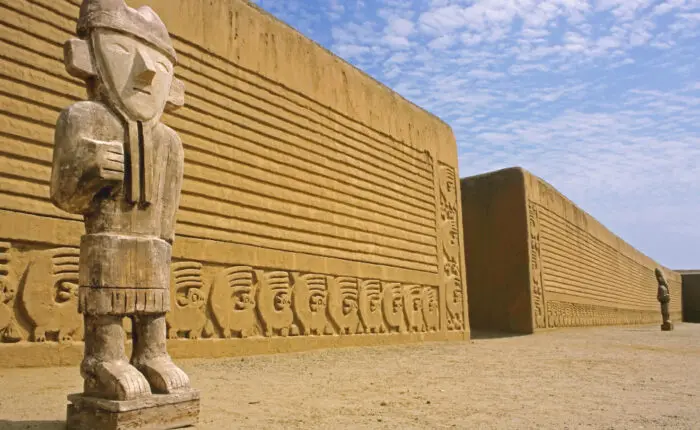
Ancient Cultures Peru Tour
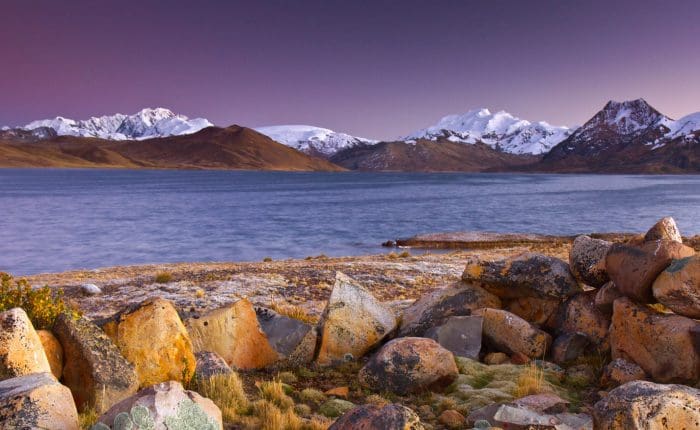
Express Quelccaya Trek
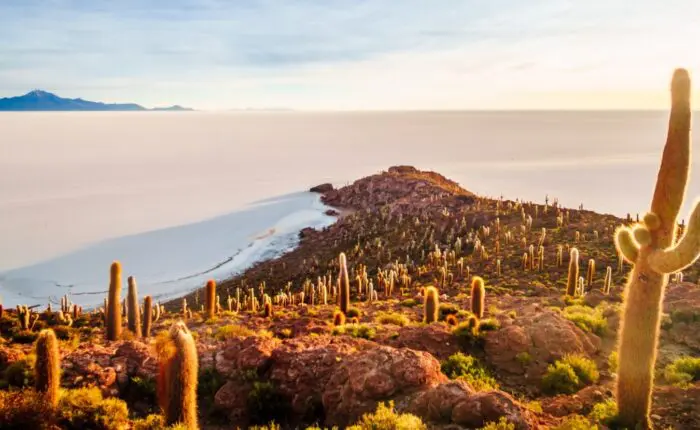
Peru and Bolivia Tour Package

Machu Picchu Galapagos Islands Tours

Lares Trek – Active Tour
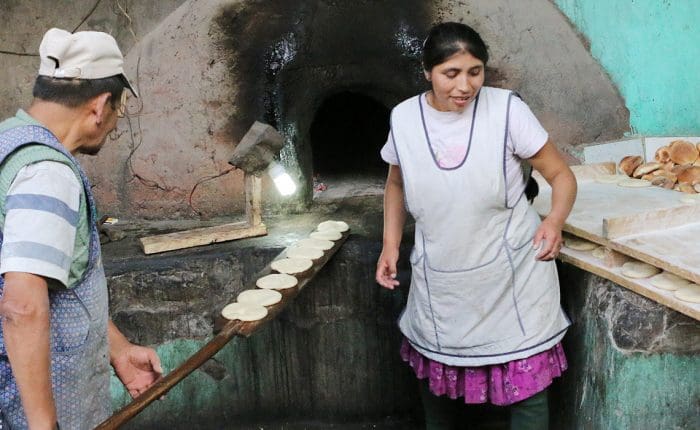
Peruvian Food And Culture

Machu Picchu Luxury Tour Package
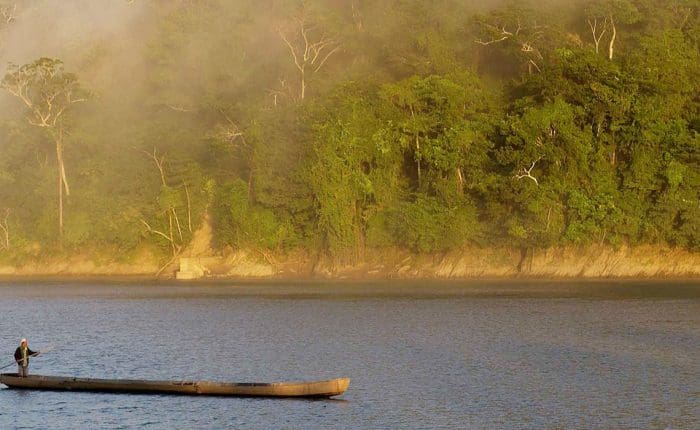
Machu Picchu and the Amazon
Proceed booking, or continue as guest, request a quote.
Contact No.
Your Location
Intrested in
Chachapoyas & Kuelap
Discover Chachapoyas Archaeological Site in the Peruvian Cloud Forest
The ancient wonders of the Chachapoyas Archaeological site nestled in the enchanting Peruvian Cloud Forest with our expertly curated Peru Tours
Unveil the mysteries of the Cloud Warriors during your Peru Tours in Chachapoyas. Dive deep into the nature, wildlife, and archaeological marvels of Peru’s hidden treasures on the less-traveled Northern Circuit.
Explore the legacy of the Chachapoyas, an ancient civilization dubbed “The Warriors of the Clouds”. Encounter the awe-inspiring grandeur of Kuelap, often referred to as the “Machu Picchu of the North”, standing tall as one of America’s most remarkable ancient stone structures.
Experience Chachapoyas

GASTRONOMY 1 / 4
If your taste palette is adventurous, then Chachpoya is an ideal place to try Peruvian delicacies such as Cuy (Guinea pig). In this cloud forest, you’ll able to find many restaurants offering tasty, traditional cuisine with the more popular dishes being Cecina and trout.
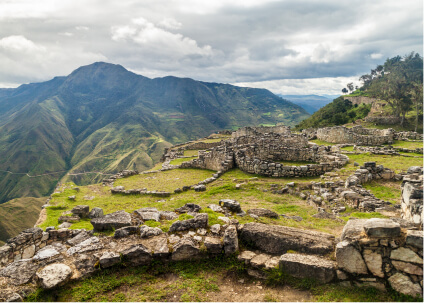
CULTURE 2 / 4
Belonging to and built by the former pre-Inca Chachapoyas culture, the Kuelap fortress is a sight to experience while traveling in northern Peru. The complex consists of an impressive 20-meter (66-foot) tall stone wall and 420 circular stone houses adorned with interesting zigzag and geometric designs. You’ll be wowed by the seemingly intact condition of this ancient structure built in 500 AD.
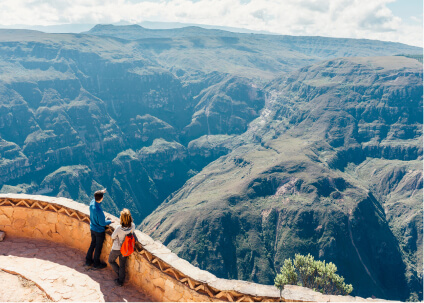
ADVENTURE 3 / 4
The Chachapoyas region is a hub for any number of cultural and nature excursions, including everything from visits to record-breaking waterfalls to dizzyingly deep canyons and the unique pre-Inca ruins of the Chachapoyas culture. Fill your itinerary with ruins tours, horseback riding along canyon trails, and gentle strolls through the Amazonian cloud forest.
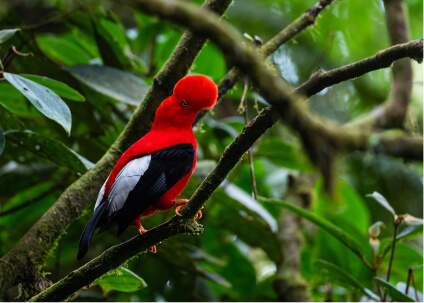
NATURE 4 / 4
Standing at an impressive height of 771 meters, the popular Gocta waterfall is a sight that cannot be missed when visiting this region of Peru. Take a 2-hour trek through the Peruvian cloud forest to experience the power of this cascading wonder. Or take a visit to the recently discovered Yumbilla waterfall which is even taller with a height of 895 meters! And on the way to these destinations, be on the lookout for the beautifully colored ‘Cock of the Rocks’.
BROWSE THROUGH SAMPLE
Signature peru itineraries, our custom-designed itineraries are suited to the needs and preferences of each traveler, every time..
When booking luxury Peru tours, we’ll keep your travel goals in mind – whether you’re looking to experience the biodiversity of the Amazon, eat your way through Lima, or explore the Inca city of Machu Picchu – Peru has something for everyone and our travel designers are eager to craft the perfect trip for your luxury vacation to Peru.

THE AMAZON & MACHU PICCHU 10D / 9N
Discover Peru’s most bucket-list-worthy destinations. Explore a blend of magnificent, unspoiled nature and fascinating historic…

SIGNATURE PERU & BEYOND 9D / 8N
Embrace the once-in-a-lifetime opportunity to explore the most incredible destinations in a luxury tour of Peru. Walk on sacred grounds…

MACHU PICCHU LUXURY TOUR 8D / 7N
Masters of farming, engineering geniuses, and creators of a religion that combined features of animism and nature worship…
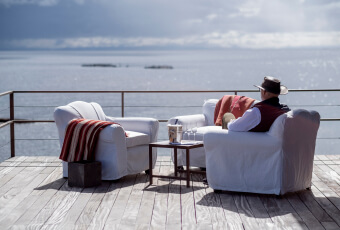
DISCOVER SOUTHERN PERU 13D / 12N
Explore the fascinating history and vibrant scenery of southern Peru, a destination unlike any other. Dine on authentic cuisine…
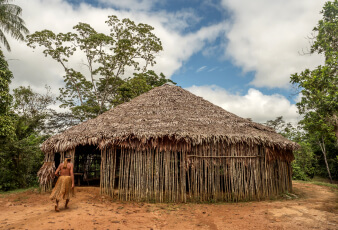
THE AMAZON, MACHU PICCHU & LAKE TITICACA 12D / 11N
A fantasy adventure awaits you in Peru, exploring the Amazon, Machu Picchu & Lake Titicaca all at once! From the lush Amazon…
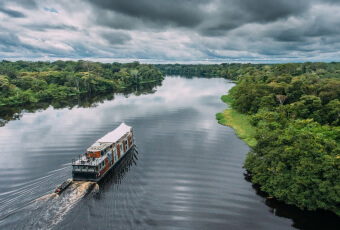
THE ULTIMATE LUXURY AMAZON CRUISE 11D / 10N
Set sail on a luxury Amazon cruise down a mythical river, exploring the world’s largest tropical rainforest: the Amazon jungle…
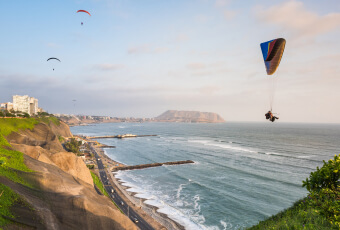
PERU FAMILY TOUR 8D / 7N
Embark on the ultimate family vacation to Peru, discovering the best family-friendly destinations throughout this fascinating…
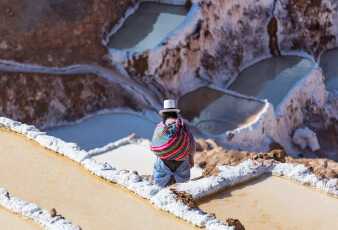
A JOURNEY THROUGH A FABLED PAST 12D / 11N
Uncover the secrets of Machu Picchu with a hidden gem excursion retracing the original Inca path stemming from Cusco. Discover…
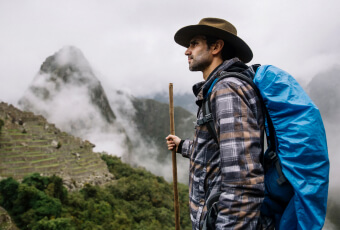
CROSSROADS OF HISTORY 10D / 9N
Venture into the heart of the ancient Inca Empire as you challenge yourself to complete the legendary Inca Trail to Machu Picchu…
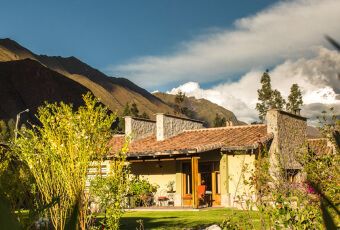
ROMANTIC ANDEAN GETAWAY 12D / 11N
As a country, Peru brims with romantic sentiment musically, gastronomically, and geographically. The Andes alone is an…
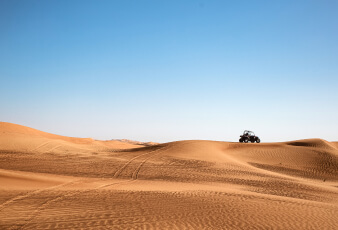
PERU ADVENTURE TOUR 11D / 10N
Regal mountains loom over a fertile valley that follows an ancient river, waters of which whisper colorful stories of Inca glory and…

SAVORING PERU’S CULINARY TREASURES 10D / 9N
Peruvian cuisine has been made famous by the likes of world-renowned Peruvian chefs Gaston Acurio and Virgilio Martinez, and is…
DISCOVER THE
Best time to travel, chachapoya experiences a rainy & dry season, but your preferences will help determine what’s the best time to visit..
For clear skies & comfortable temperatures, travelers should visit Chachapoya during the winter, between the months of June through August. If you are interested in seeing Gocta & Yumbilla waterfalls at their peak beauty, then it is advised to visit during the rainy season of December to July. More info
BEST MONTHS TO VISIT
Insider tips, get the insider knowledge from experts in travel, with on the ground experts proudly born and raised in peru, the kuoda team knows the ins and outs of the country as locals, and the best way to experience it as travel industry experts..
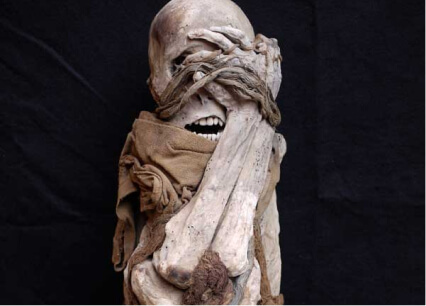
WHAT TO SEE AND DO 1 / 3
Visit the Ancient Mummies at Museo Leymebamba Near the Laguna de Los Cóndores lie a 500-year-old burial site that began to be excavated in 1997. Archaeologists were able to uncover 200 mummies along with burial offerings, ceramics, and weapons. The Chachapoya people were talented embalmers, leading to the eerily well-preserved mummies that can be viewed today from the Museo Leymebamba.
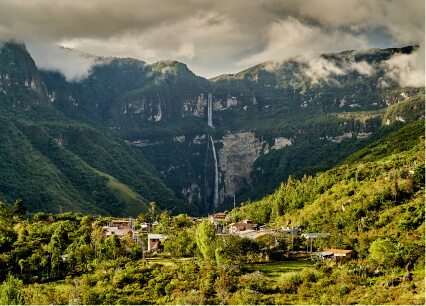
WHAT TO SEE AND DO 2 / 3
Hike to the Gocta & Yum Waterfalls These jungle waterfalls have two tiers towering at 771 meters tall making it a highly impressive sight that you won’t want to miss. A full-day hike can take you to both the upper and lower tiers of the falls in one 15-kilometer circuit along with a viewpoint that provides an astonishingly clear view of both of the falls. The recently discovered Yumbilla is even taller standing at 895 meters and is about a 10-kilometer hike in total being accompanied by a view of two other waterfalls along the way.
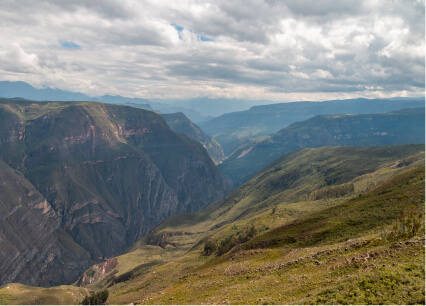
WHAT TO SEE AND DO 3 / 3
Visit Canon del Sonche This steep-sided canyon is a must-visit with walls up to 2620 meters above sea level as well as astounding views of the Sonche River which runs through the river bed. Hike to the top of Mirador de Huancas to have the perfect view of the impressive landscapes inhabiting the Sonche Canyon. Get a guided tour in order to have a skilled local help spot out the impressive array of birds that inhabit this region.
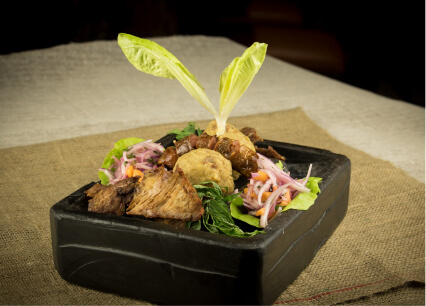
WHERE TO EAT 1 / 3
El Batán del Tayta From the furry seat covers to the dramatically presented cuisine, your dining experience is ensured to be interesting and delightful. The innovative menu ranges greatly from ‘drunk’ guinea pigs to ant cocktails. Don’t worry if you’re put off by insects and rodents – they offer traditional Italian pasta if you’re feeling less adventurous. Truly, a gastronomic experience like no other, El Batán del Tayta should not be missed on your Chachapoya trip.
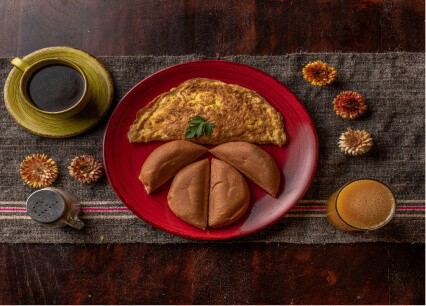
WHERE TO EAT 2 / 3
Café Fusiones This welcoming restaurant has a lovely outdoor courtyard as well as a cozy indoor seating area to enjoy delicious, regionally-focused food. Both the coffee and WiFi are strong, making it the ideal location to unwind after a day of exploring. Interested in learning about the process of coffee? Café Fusiones has an on-site laboratory where you can learn about how the bean transforms into a delicious cup of coffee.
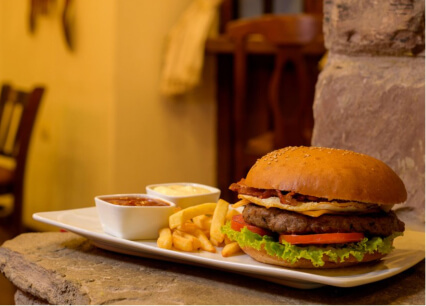
WHERE TO EAT 3 / 3
Terra Mia Cafe Located in the main square, this trendy Peruvian-style cafe is famous for serving deliciously authentic food at just about any hour of the day. Terra Mia Cafe welcomes guests with a cozy indoor dining experience accompanied by WiFi making it the perfect atmosphere to unwind after a long day. The portions are generous and the options are plentiful with welcoming staff to keep your stomachs full and hearts warm.
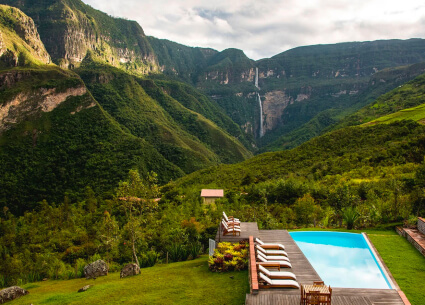
WHERE TO STAY 1 / 3
Gocta Andes Lodge The Gocta Andes Lodge is tactfully oriented so that visitors can experience breathtaking views of the Gocta Falls from the comfort & ease of your private balcony. Take in the incredible views as you experience a taste of the local area with fresh trout coming from the Leymebamba, incredible cheese from Pomamcochas pastures, and smooth coffee arriving from Mendoza. This tranquil basecamp will serve you with the luxury you desire while being in close proximity to memory-worthy adventures.
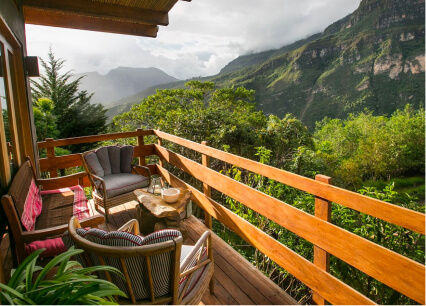
WHERE TO STAY 2 / 3
Gocta Natura Cabins Hidden within the cloud forest, Gocta Natura Cabins is an environmentally-friendly luxury accommodation dedicated to regenerating the forest. The private cabins provide great comfort along with picturesque views of the nature reserve. Experience farm-to-table culture as Gocta’s restaurant curates daily menus based on the produce availability of their gardens. Not only do they focus on the health of the environment but also of their guests, offering activities meant to harness creativity & peace.
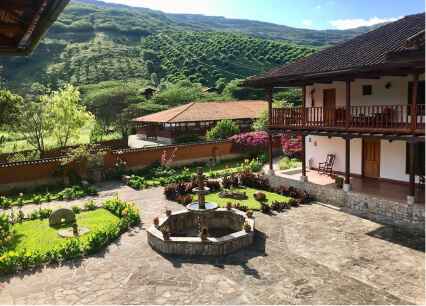
WHERE TO STAY 3 / 3
Casa Hacienda Achamaqui This eco-friendly, wooden haven offers guests a comfortable stay without the expense of harming the local environment. Strategically located, the hotel sits within a 32-mile radius of the National Institute of Culture Museum, Gocta Waterfall, and Kuelap. Casa Hacienda Achamaqui offers a traveler's connection to nature being wrapped around a lush forest & an accessible river. The hotel’s restaurant will cater to your needs through delicious food and amazing service.
DESTINATIONS
To discover in peru.
Embark on a journey through Peru’s UNESCO World Heritage Sites , from the iconic Machu Picchu to the mysterious Nazca Lines. Immerse yourself in the rich tapestry of history and the wonders of nature. Before we begin crafting your perfect custom Peruvian vacation, take a moment to explore some of Peru’s most beloved destinations for inspiration on what to include in your personalized Peru tour.
Immerse yourself in the “City of Kings”, Latin America’s culinary capital, which boasts extensive colonial architecture on the UNESCO World Heritage List.
Cusco was the heart of the Inca Empire and is filled with masterfully crafted Inca stone relics. Discover the best of Cusco with a customized tour.
SACRED VALLEY
Sacred valley.
Just a one-hour drive from Cusco, shadowed beneath the emerald Andean peaks lies the Sacred Valley of the Incas. Here, you’ll find peaceful villages.
MACHU PICCHU
Machu picchu.
New World Wonder Machu Picchu deservedly tops the agenda of most visitors to Peru. Set on a lofty plateau surrounded by the soaring and dipping Andean peaks.
PUNO & LAKE TITICACA
Puno & lake titicaca.
Peru’s folkloric capital meets the world’s highest navigable lake; if you travel to Peru, consider living the cultural experince in the islands around Lake Titicaca.
TAMBOPATA PERUVIAN RAINFOREST
Tambopata peruvian rainforest.
We welcome you to explore some of the cultural and indigenous treasures and unique wildlife found in the Tambopata National Reserve.
ICA, NAZCA & PARACAS
Ica, nazca & paracas.
Ica is the starting point for many tours to Nazca and Paracas, and has its own attractions: for desert lovers, sandboarding and dune-buggying thrill seekers.
AREQUIPA & COLCA CANYON
Arequipa & colca canyon.
With its UNESCO-listed historic center and magnificent volcanic vistas, Arequipa and Colca Canyon is a wonderful stop on a customized Peru tour.
TRUJILLO & CHICLAYO
Trujillo & chiclayo.
Peru’s cultural capital, it was the base of the Moche and Chimú civilizations, cultures known for their gold, silver, pottery and architectural creations.
PERU'S NORTHERN BEACHES
Peru’s northern beaches.
Enjoy a dazzling beach vacation in Peru’s surf and sun mecca, with its reliable year-round sunshine, pristine coastline, stylish hotels, and burgeoning food scene.
IQUITOS & THE AMAZON RIVER
Iquitos & the amazon river.
Iquitos makes an excellent base from which to set off on luxury tours. Amazon luxury cruises are a popular option and most commonly depart from the port of Nauta.
CHACHAPOYAS & KUELAP
During your visit to Chachapoyas, explore the nature, wildlife, and archaeological treasures of Peru’s less-traveled Northern Circuit.
BE INSPIRED BY KUODA’S
Travel blog.
New destinations and gain insight of your future travels with our latest blog posts.
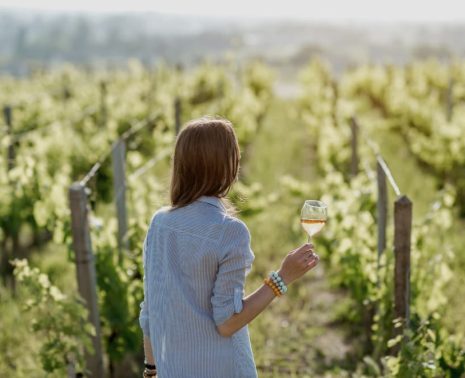
Sip Responsibly at The Most Sustainable Vineyards in Argentina
Argentina's wine industry is not only renowned for its exceptional quality but also for its commitment to sust...
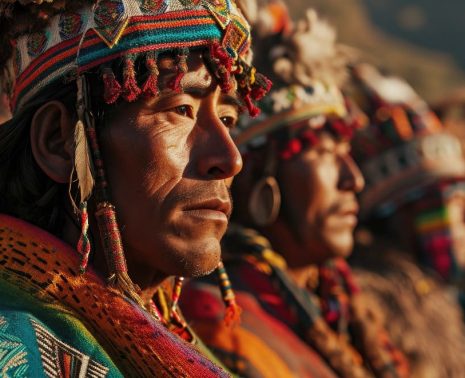
Kuoda’s Guide to the 2024 Inti Raymi Festival
The 2024 Inti Raymi festival will stand as a tribute to the grandeur of the Inca Empire, steeped in centuries ...
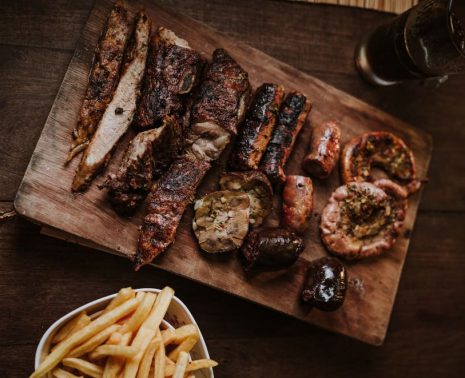
The Best Places To Try Asado In Argentina on Your Foodie Trip To South America
When you travel to Argentina, remember that dining is not just a meal; it's a celebration of life, culture, an...


Should You Visit Kuélap, Peru’s Alternative to Machu Picchu?
By Author Steph Dyson
Posted on Last updated: 6th October 2023
I’ll admit to not being a huge follower of travel lists published by the big travel companies (even if I’ve contributed to them over the past few years).
Although they can be a great way of highlighting truly fascinating travel destinations that would otherwise get overlooked, they can also help to perpetuate the challenges that many growing tourism destinations face.
One of these is Kuélap, a mountaintop citadel built in the sixth century by the Chachapoyas culture that overlooks the Uctubamba Valley in northern Peru, has been on the receiving end of increased global attention.
Ranked at number 29 on the New York Time’s 52 Places to Go in 2018 list, the “experts” really think you should add it to your travel bucket list this year (another term that I just can’t get behind).
Regardless of its appearance on this list, I’ll admit to having been excited about the prospect of visiting the ruins for as long as I’d known I was going to be heading back to Peru.
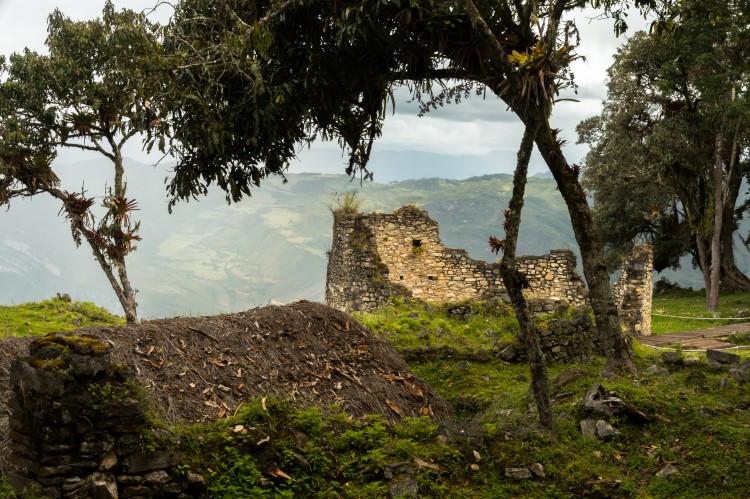
Unlike Machu Picchu , a photo of which you can’t go more than a few steps into the country without being bombarded with from all angles, I thought that it had a sense of being untouched by tourism, seemingly resistant to the effects of mass visitation – largely because, plonked strategically on the top of a mountain, it remained difficult to access.
Click to navigate this article:
Broadening access to Kuélap, the cloud warrior fortress
But things have changed. Last year, a French company received a contract to build a cable car from Nuevo Tingo at the base of the mountain to the ruins, streamlining a journey that had taken anything from 90 minutes (minibus) to four hours (hiking) down to a mere 20-minutes.
The resulting transport is run with the precision that I wasn’t aware was even possible in this country: in the waiting room just above the town, a screen indicates the timing of the next minibus that will take you to where you board the cable cars (ours left at exactly 10.17 for example).
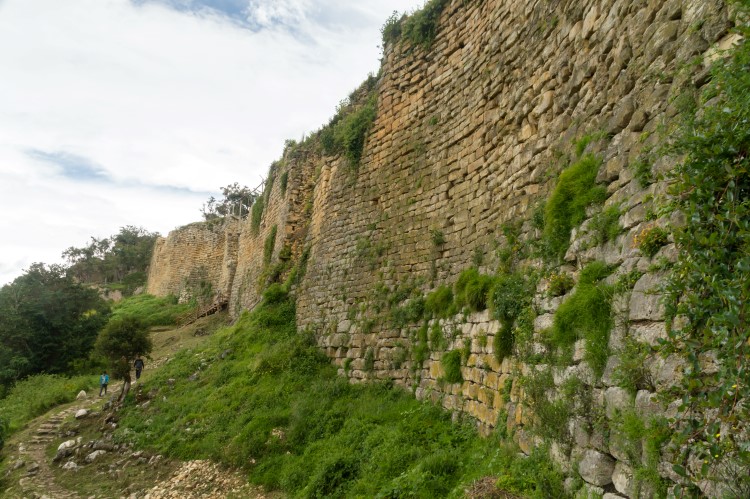
You’re even expected to queue up in an orderly fashion five minutes ahead of your allotted time slot to ensure the smooth running of the schedule.
It’s certainly efficient; within 20-minutes, we’d faced a somewhat hairy plunge down into the valley, before being yanked back up the other side and spat out at the visitor’s centre.
Planning Your Trip to Peru?
Save time, stress & money with a customized travel itinerary planned for you by a Peru expert
What previous clients have said:
Going to a new and exciting place is an adventure AND has its challenges. Being able to carve out an in-depth plan with someone that has been there and whom you can trust was extremely helpful. We felt comfortable embarking on a six-week backpacking trip with kids ages 8 and 11 with Steph on our team. Her expertise and ability to hear what we wanted gave us a great jumping point for planning. Her advice and wide array of options also allowed us to be flexible. It also gave us peace of mind knowing that we had someone we could call if our plans went awry. Every one of Steph’s recommendations panned out to be incredible pieces of our trips and we would highly recommend her!
En route, my guide pointed out holes in the mountainside where the interred bones of previous inhabitants of the region were visible from our seats in the cable car.
Once we arrived at the top, it was another 10 minutes on foot to reach the ruins – although enterprising locals were on hand to provide horses for those who weren’t sure about the required exertion.
It was at this moment that the dream of this mystical stone fortress atop a mountain, a place from where the Chachapoyas had surveyed their territories and protected themselves from their enemies before finally being subsumed into the Inca empire, started to fade.
As we passed the dramatic stone walls that surround the Kuélap fortress – not nearly as slick as those for which the Inca are famed, but still reaching up to 18 metres in height – we could see many being rebuilt, an act that I can only hope does not see the ruins following those at Machu Picchu – which I’ve been told have been rebuilt to almost beyond recognition.
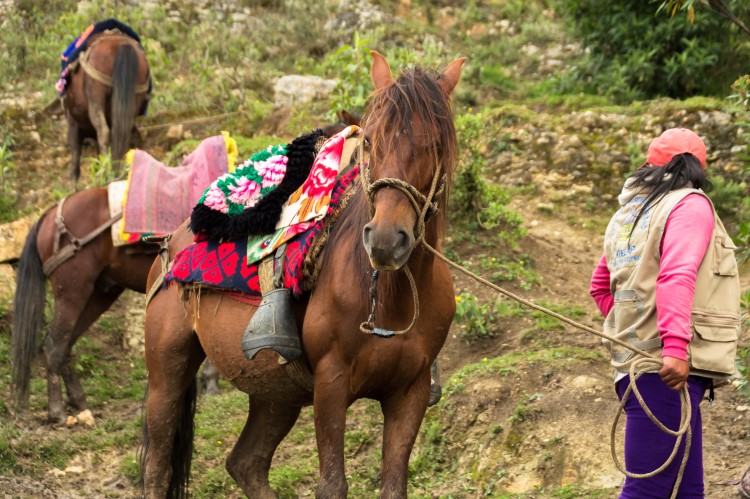
Entering the ancient city from the east, we climbed upwards to the first level of circular stone houses, only to find ourselves competing with another group busily taking selfies and standing on the ruins themselves.
This was much to the annoyance of our tour guide who was repeatedly being forced to break off from her explanations and chastise members of other groups for this behaviour.
Stoning the clouds
Despite this, the ruins themselves are truly spectacular. There’s always something about mountain-top buildings that leaves you truly in awe, from the question of how on earth they managed to get all of those rocks up there to the sublimity of the views.
Like the Inca, the Chachapoyas wanted to get as close to the sky as possible, so the Kuélap fortress’ position is both strategic and religious.
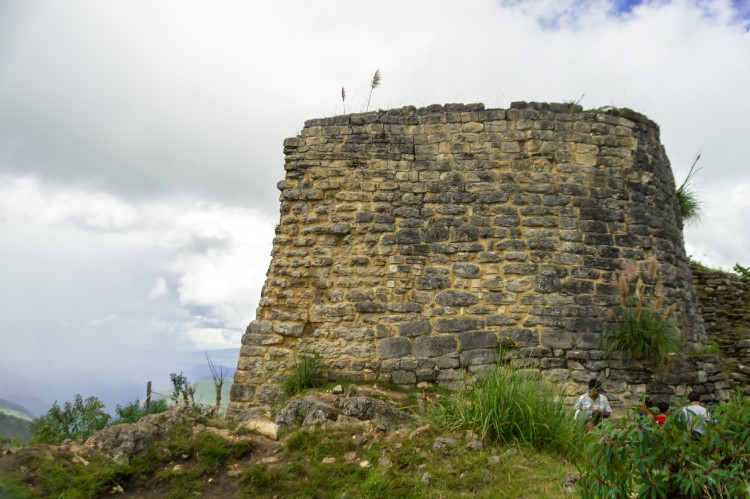
At the northern end of the ruins, we stood in front of the remains of a tower where over 2500 stone projectiles had been found: here, our guide told us how archeologists believe that the Chachapoyas had catapulted stones up into the sky to “hit the clouds and bring down the rain”.
Further along our loop around the site, we stopped at the remains of a circular house, the walls only now a metre or so above the ground.
Our guide pointed at a stone tunnel that’s just about visible beneath a layer of grass and which is where they stored their guinea pigs – which were later cooked up and eaten, of course.
But that’s not all; our guide pointed again at the ground. “The Chachapoyas lived with their dead,” she tells us, describing how the mummies of the deceased would have been buried beneath the dwelling and covered by a slab of rock that could be removed to take them out again for rituals or celebrations.
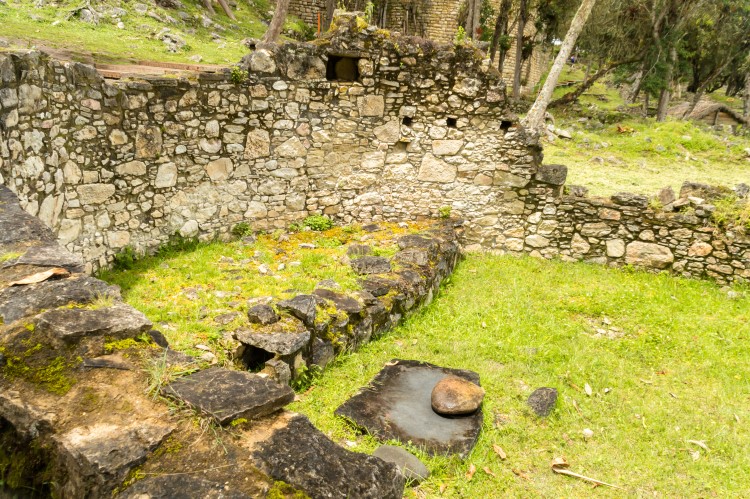
As we wandered around the site, it was hard not to be struck by its height – the ruins stand at 3040m above sea level – and the sheer drop that surrounds this mountaintop plateau from all angles, with the other mountains disappearing into a haze of cloud.
A cable car too far?
Even though it still felt there were a few too many people for my liking, I was certainly glad that I was there in January; apparently, in the peak months of June and July, visitor numbers can reach up to 1800.
Given how the Inca Trail and Machu Picchu has recently had to change its ticketing system in a bid to lessen the impact of thousands of daily visitors to the site (although, as this article points out, visitors’ numbers are set to increase under the changes), it is concerning to think about what impact increasing tourism and the new improved access will have on the ruins.
What’s more, conversations I had with people living in and around Chachapoyas proved how the introduction of the cable car has had other negative effects on tourism in the region.
Previously, the minibuses would take the long route around to Kuélap, passing via the village of Choctamal among others, stopping for lunch in restaurants along the way and even staying the night in accommodation en route .
The cable car has effectively cut these communities off from the tourism that had served as their main income for many years.
Visiting Kuélap, Peru: can it be done responsibly?
I enjoyed my trip to the ruins, although the experience certainly made me aware that there’s little energy being spent by the Peruvian government or tourism board on controlling access to the ruins so that they don’t end up facing the same challenges as Machu Picchu.
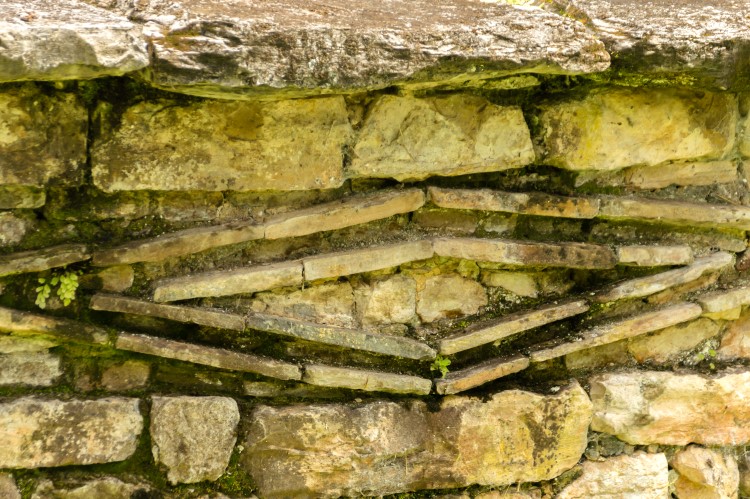
What this means is that it’s on us, as travellers, to consider how best we can visit the ruins responsibly. These are my suggestions for visiting Kuélap:
- Head to Kuélap out of high season (June-August), where possible. While it’s tempting to plan your Peru travel itinerary for these months, arriving out of peak season helps to spread out the arrival of visitors, which is not only a bonus for you, as you’ll be sharing them with few others, but helps to ensure tourism is a year-round source of income for the local families who rely upon it. Bear in mind that February-April is the rainy season and access to Chachapoyas can be difficult, so these months are best avoided.
- Consider taking the old route that passes through local communities, rather than the cable car. Yes, the cable car was beautiful (if a little terrifying at times), but adding an extra 90-minutes to your trip time isn’t the end of the world – but can make a real difference to local people. Even better, consider spending the night at one of the accommodations close to Kuélap ; not only will your money go into local coffers, but you’ll also be able to enter the site before all the tour groups get there.
- Don’t wander on the stones! Even though the site is very open and you can visit without a guide, this doesn’t mean you can stand on the ruins themselves. Some of the parts of the path are very narrow and difficult if you’re trying to pass another visitor but hey, don’t step on the stones!
Finally, there’s so much more to see in the Uctubamba Valley than just Kuélap, with the region comprising a veritable collection of sarcophagi, hikes to ancient burial sites, private conservation areas and sustainable ecotourism projects.
By exploring the region, you can help to broaden the positive impacts of tourism and reduce the negative ones, such as overcrowding and the domination of big, multinational businesses over small, sustainable local enterprises.
To get you started, have a read of this article about the best responsible tours (visiting small-scale, often community-run tourism projects) in Northern Peru .
Useful information about visiting Kuélap, Peru
How to get to kuélap, peru.
I visited with Nuevos Caminos Travel , who specialise in responsible local tourism and offered a no stress way of visiting Kuélap, particularly given the short timeframe I had to do so.
Their tours cost S/95 ($30 USD) and include transport from their office on the Plaza de Armas, Chachapoyas to the cable car station and back again, plus lunch in a local restaurant and an English-speaking guide.
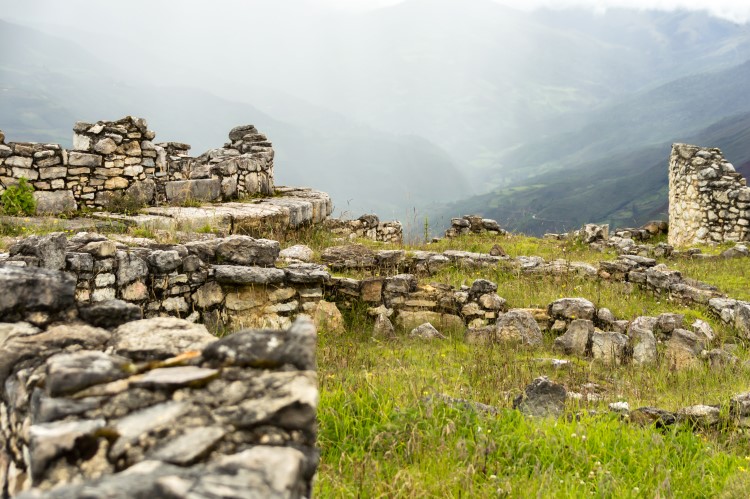
They can also arrange hiking tours (with a cable car up and the hike down) and have a wide range of other tours visiting fascinating local destinations, such as Mipuj, Yumbilla, the Coffee route and even Leymebamba and the Laguna de los Cóndores (where the mummies in the Museo de Leymebamba were uncovered).
You can also visit independently by taking a colectivo (minibus) from the bus station in Chachapoyas. A return ticket costs S/14 ($4 USD) and will drop you off at Nuevo Tingo.
From here, the cable car costs S/20 ($6 USD) each way and run daily 8am–5pm (although they’re closed most Mondays for maintenance); the final cable car down leaves at 3.30pm. The earlier you get there, the less likely you’ll be vying for photography space with the crowds.
For more information about getting to Kuélap from the town nearest the ruins, read our complete guide to Chachapoyas .
What to take with you to Kuélap, Peru
Wear walking boots as the path up to the fortress can be muddy if it’s rained and you cover a few kilometres as you wander the site.
A waterproof coat , hat, sunscreen and water are essentials as the weather can change rapidly in the space of a few minutes.
I was a guest of Nuevos Caminos Travel for my trip to Kuélap, although, as always, all of the opinions in this article are mine and showcase my honest opinions of the experience. Their sustainable tours incorporate a wide range of different attractions from the Uctubamba Valley and Chachapoyas.
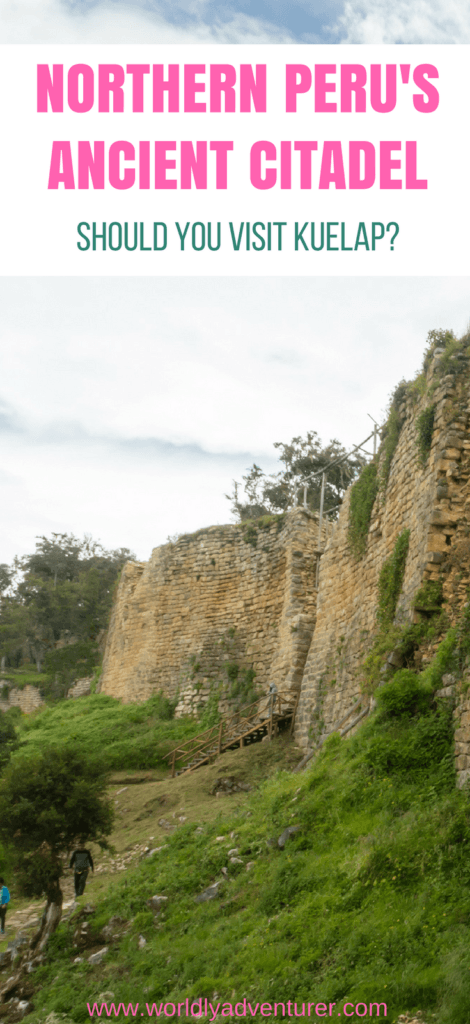
Sunday 29th of May 2022
I fortunately got to visit last November and loved the area. Sadly the recent rains brought down a section of the wall some weeks back
Steph Dyson
Thursday 23rd of June 2022
That's a real shame. Hopefully they'll be able to restore it!
Sunday 13th of September 2020
I have worked in the Chachapoyas area for the past 5 years studying birds for my PhD. One of our sites is in Choctamal, and we watched the teleferico being built. My impression is that it is probably helping tourism in Chachapoyas and Nuevo Tingo, because most tours start and end there. Nuevo Tingo has changed enormously, going from a quiet desert town to a tourist center. However, it has been devastating to the communities on the route to Kuelap. The hotel and restaurant in Choctamal used to serve meals to 50-150 people a day. They had just finished major renovations when the teleferico came - now it is closed and the owners have moved to Chacha and Tingo. Consider stopping at the Huiquilla Private Conservation Area in Choctamal. They have nice accomodations and food and will take you up a beautiful trail through the cloud forest to an ancient ruined city on the ridge with distant views of Kuelap. You'll have it all to yourself.
Saturday 21st of November 2020
Hi Ian, thanks so much for the recommendation and for providing some context about the impact of tourism on the local area - something that I know is always helpful for readers when making their decisions prior to take a trip. Steph
Jorgen hellman
Friday 27th of September 2019
Back in 1996 Kuelap was just a short entry in the Lonely Planet guide to South America. My French friend and I travelled by local transport, stayed in a small family house come backpackers hotel and it took us a gruelling 4.5 hours to walk up the switch back trail to the top of the hill. This was with just a litre of water each, which disappeared pretty quickly! Luckily there was a farmers well near the top where we drank our fill. There were only two other people there that day, we spent most of the day just wondering around and camped just outside the city walls. Truly one of my greatest days. I just can’t imagine that place with a cable car!!!
Thursday 10th of October 2019
Jorgen that sounds fascinating! Thanks so much for sharing what the experience was like. And yes, the cable car is definitely an interesting addition...I think I would have preferred it your way! All the best, Steph
Anna Guengerich
Wednesday 4th of April 2018
I found a link to this website via the Nuevos Caminos facebook page. I'm an archaeologist who's been working for ten years in this region; when I first visited Kuelap in 2007, there were less than 10 people at the site. I appreciate seeing a travel review that is informed by critical thinking. Even though greater economic development through tourism is a goal for the region, the way in which this has taken place at Kuelap has not been guided by a sense of social responsibility for neighboring communities, or for the conservation and scientific understanding of this incredible site. I second your recommendation to take the minibus in order to contribute to towns like Maria and Choctamal that have been hit badly by the cable car (plus, the minibus ride is one of the most exciting and scary routes you can take in Peru!), and also your recommendation to look beyond Kuelap. Especially if you like hiking, you just have to ask around locally and you will find plenty of remote and beautiful routes with few people-- a good source is asking for the Association of Guides (Asociacion de Guias) in towns such as Leymebamba.
Hi Anna, thank you so much for your comment and your recommendation that people contact the Association of Guides in local towns. I think it's very important that people are aware of the issues facing the development of tourism in places such as Chachapoyas (having lived in Cusco I've seen the impact, both positive and negative, first-hand there) so that they can make responsible decisions about the way they travel. Hopefully this can go towards supporting the really excellent sustainable projects I saw being developed in the region and which offer hope for local people managing tourism on their own terms. Thanks so much for the comment and for sharing your experiences! Steph
Are you sure you want to close the session?
La cuenta ya se encuentra activa
Or enter your e-mail:
Recover your offer
We will send you a 4-digit code shortly
Enter the 4-digit code and your new password
Enter your search here
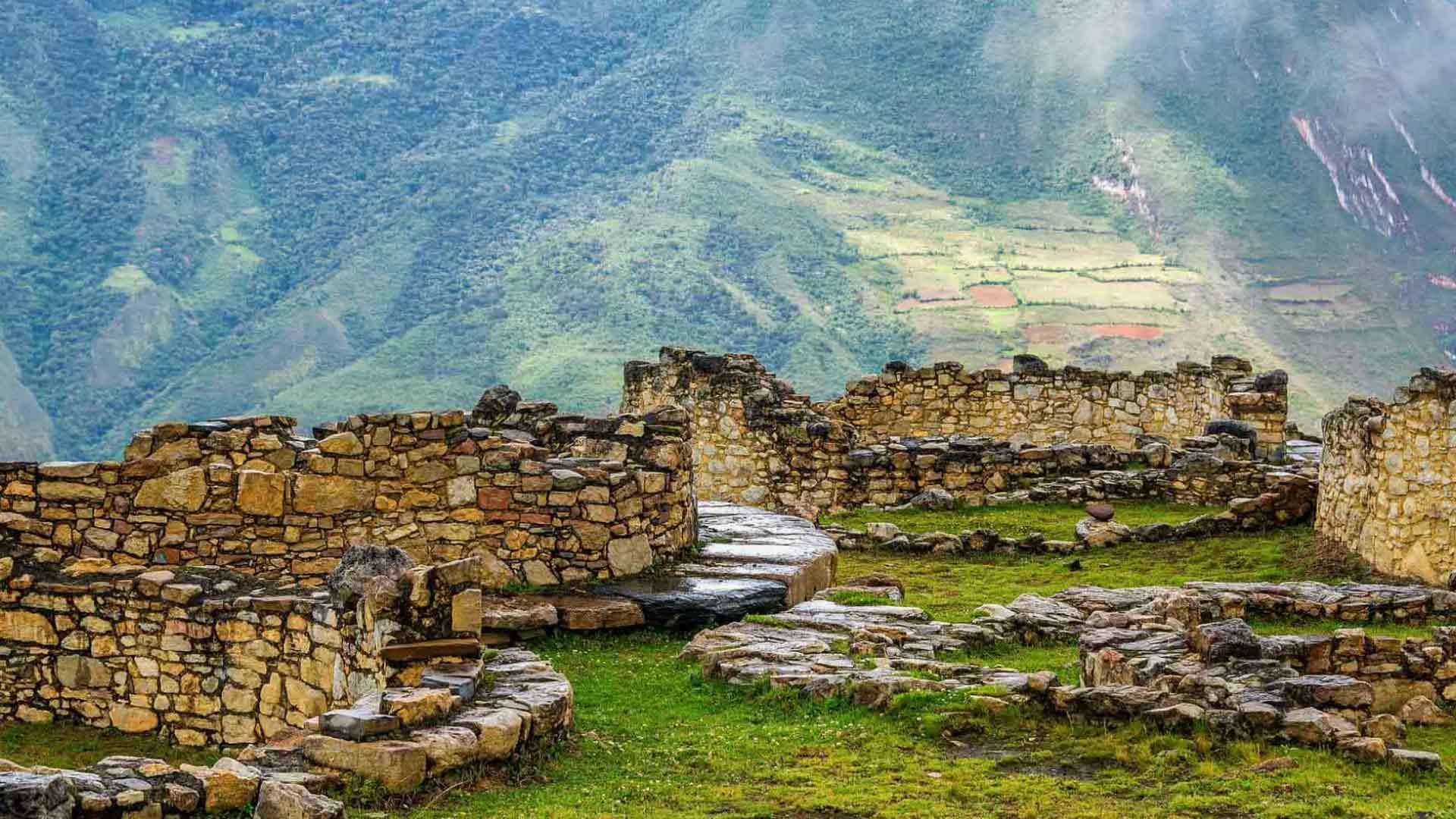
- Kuélap opens its doors to tourism
Kuélap Credit: Shutterstock
Peru Travel
The Monumental Archaeological Zone of Kuélap, one of the most emblematic attractions in the Amazonas department , reopened its doors on August 19th. Admission is free for Peruvian and foreign visitors, regardless of residence in Peru, until December 31st of this year.
However, there will be limitations on the number of visitors to the fortress in order to preserve the area in good condition. It has been planned that only a maximum of 144 people can enter daily in different shifts.
How to reserve a visit to Kuélap?
It is important to request a spot through a travel agency or independently by writing to the e-mail [email protected] , attaching Annex 2 for travel agencies and Annex 3 for independent visitors. You can also check the availability of visiting shifts by calling (+51-1) 618-9393 Extension 6041; reservation hours are from Monday to Friday from 08:30 to 13:00 and from 14:45 to 18:00, and Saturday and Sunday from 08:30 to 13:00.
You must go to https://kuelap.cultura.pe to download Annexes 2 and 3, as appropriate.
Cable car tickets can be purchased in the district of Nuevo Tingo, with payment options in PEN with cash or through Peruvian platforms like Yape and Plin. Only backpacks with a maximum size of 55 x 35 x 25 cm are allowed. Excess baggage will require an additional ticket. For more information, write to [email protected] or visit www.telecabinaskuelap.com .
How to get there?
The first step is to reach Chachapoyas , either by air or by land. From there, you can choose to take the available buses to the friendly town of Nuevo Tingo.
You can reach Kuélap on foot (5 hours) or by car (3 hours). However, a novel option is to do it through the cable cars. For this, you will need to take a bus from Nuevo Tingo to the departure platform, which is about a 10-minute journey. Then, you will travel to the arrival platform at the Kuélap tourist stop in La Malca, which takes approximately 20 minutes, allowing you to enjoy the impressive landscapes with a privileged view. Afterward, there is a 30-minute walk to reach Kuélap.
What does the tour consist of?
The tour begins at the main entrance of the site, known as entrance 1(A). This corridor, approximately 60 meters long, has walls with intricate carvings of zoomorphic and anthropomorphic representations.
Next, there will be three stops where you will visit the interior of the houses and other areas of the fortress. You will be able to appreciate the enigmatic architecture of the Chachapoya culture, and at times, you will receive information about the excavations carried out in the area.
Important considerations to take into consideration
To ensure an enriching visitor experience, the following organization system has been established:
● Visits will be conducted in small groups, with a maximum limit of 12 people per group. Each group can have a guide if desired.
● There are 12 visiting shifts established. These shifts are staggered, with 45-minute intervals between each one.
● Visitors must wear safety helmets throughout the tour, which will be provided by the Department of Culture of Peru or the travel agency hired to guide the visit.
● Punctuality is important, as the group of visitors who are not present at entrance 1 at the scheduled time will lose their visit slot for that day. If you are traveling independently, you should depart with a minimum of 2 hours in advance from Chachapoyas to arrive on time.
Learn more about the visit protocol, space availability, reservation formats, and everything about the efforts being made to restore this monument at https://kuelap.cultura.pe/ . This portal will also provide information about any modifications to the trails, circuits, and/or restricted areas, as well as the entry and service hours.
The reopening of Kuélap invites us to embark on a journey through time, where the architectural majesty of ancient civilizations comes to life and merges with the natural beauty of the region. This experience not only enriches our knowledge but also inspires us to value and preserve the past for future generations.
Ver esta publicación en Instagram Una publicación compartida por peru (@peru)
Follow us on social media Facebook | Instagram | Twitter | TikTok | YouTube
Related news
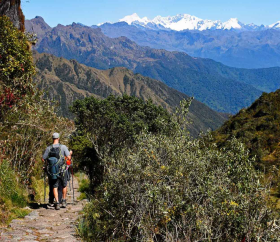
The Inca Trail is recognized by Tripadvisor as one of the best experiences in the world ...
The route was chosen by travelers who highlight the impressive mountain landscapes that are obser ... ...

Inca Trail to Machupicchu: One of the Best Backpacking Trips around the World ...
The American magazine Travel + Leisure highlights this route as one of the most beautiful and iconic on the ... ...

Machupicchu is celebrating being one of the New Wonders of the Modern World ...
The historic sanctuary commemorates its momentous designation as one of the Seven Wo ... ...


Sandboarding and ancient temples: What to do in Peru if you’ve already seen Machu Picchu
Machu Picchu, the Inca Trail, Lima and Cuzco - these are indispensable destinations for any first-time traveller to Peru.
But venture off the beaten path along the Andean country’s enchanting Pacific coast and you’ll be rewarded with breathtaking natural landscapes, delectable gastronomy and rich cultural heritage.
Prepare to leave the alluring Pacific surfing beaches of Tumbes for the mountains and archaeological sites of Chavin in the National Park of Huascarán. Experience the thrill of sandboarding on the Huacachina dunes or immerse yourself in enigmatic pre-Incan cultural heritage at Kuélap or the Nazca Lines.
“Peru is an exceptionally rich and multifaceted destination, offering Incan and pre-Incan remnants, impressive cultural expressions, adventurous exploits, stunning natural beauty and extraordinary gastronomy,” Juan Carlos Mathews Salazar, Peru's Minister of Foreign Commerce and Tourism, tells Euronews Travel. “It is unquestionably evolving into an increasingly attractive destination."
A series of accolades affirm this transformation: Peru was honoured as the World’s Leading Cultural Destination and World’s Leading Gastronomy Destination at the World Travel Awards last year.
Here’s how to experience the best the country has to offer.
Go whale and bird watching in Tumbes
For nature and animal lovers, a visit to the North Pacific region of Tumbes is a must. From July to October, embark on a boat journey from Puntal Sal to witness the awe-inspiring spectacle of humpback whales giving birth to their calves before they journey back to Antarctica.
Tumbes also offers spectacular trails for birdwatching , with nearly 1,900 different species to discover. “This year, Peru has seen an increase in the number of bird species - great news for nature lovers,” says Mathews Salazar.
Encounter them in the sprawling Cerros de Amotape National Park and the protected mangroves of the Manglares de Tumbes National Sanctuary.
Impressive ancient architectural complexes: the City of Clay and Kuélap
Exploring the historical marvels of Chan Chan, the City of Clay, is a must when in Peru . Situated just five kilometres west of the coastal city of Trujillo, this awe-inspiring architectural complex, constructed in 850 BCE, served as the capital of the Chimu civilisation until succumbing to Inca rule in 1470.
Wander through the labyrinth of sun-dried clay brick constructions, marvelling at the intricately detailed frescoes adorning ancient palaces and temples.
In the heart of the Amazonas region, near Chachapoyas, lies the enigmatic ancient city of Kuélap. Nestled in the northeastern Andes, this 11th century fortress stands as a pre-Incan marvel at an altitude of 3,000 metres above sea level. Ascend via cable car for spectacular views, but remember to secure your booking in advance, as access is limited.
- Inca trails and lush rainforests: This South American country is introducing a digital nomad visa
- Spain’s new high-speed train whisks you to glacial lakes and rugged beaches
Hike past glacier lakes in Huascarán and go sandboarding in Huacachina
Journeying to the Huaraz region, discover the National Park of Huascarán in the Cordillera Blanca, a paradise of glacier lakes. With 660 glaciers and 300 lakes within the protected area, the landscape is a haven for outdoor enthusiasts.
Choose from 25 trekking trails and 102 climbing routes, with the Chavin Trail and Lago 69 Trail standing out as prime trekking options. Mountain biking, skiing, climbing, adventurous hikes, and immersive cultural tourism await in this natural wonderland .
Have you ever considered trying your hand at sandboarding ? Experience the thrill of descending the dunes in the Huacachina Oasis, just five kilometres from the city of Ica in the Pacific coast desert. A day trip allows you to explore the picturesque lagoon.
For a truly immersive experience, spend the night in a desert tent camp, gazing at the stars and witnessing the breathtaking sunrise and sunset over the dunes. Embark on a buggy ride through the desert, reaching remote dunes accessible only by these off-road vehicles, and cap it off with sandboarding down the slopes at exhilarating speeds.
Switch Machu Picchu for lesser travelled Inca sights
Contemplating the Nazca Lines, one of Peru's paramount archaeological sites, raises thought-provoking questions about their purpose and symbolism. This pre-Inca civilisation site remains shrouded in mystery, adding to its allure. When planning a visit, allocate part of your budget for a flight above the geoglyphs depicting animals, plants and humans. While a viewing tower exists, the perspective from a plane provides an unparalleled view of these ancient wonders.
For an alternative insight into Incan culture, Mathews Salazar recommends a visit to Choquequirao, often referred to as the smaller-scale second Machu Picchu .
Although a cable car is under construction for 15-minute access from the road, the current solitude of this unique site is an extraordinary experience. Exploring the ‘cradle of gold’ during the summer solstice reveals a stairway structure illuminated by the sun's rays. Gain insights into Incan astronomy and astrology while exploring this impressive fortress built for ceremonial purposes.
As you explore these awe-inspiring sites, don't forget to savour the regional dishes and revel in the cultural diversity of languages and people at every location. Peru , with its 55 native peoples, 48 native languages, and singular landscapes, unfolds as a multitude of countries within one.


IMAGES
COMMENTS
Kuelap Fortress: The Complete Visitor's Guide - Peru For Less. +1 817 230 4971Start Planning My Trip. Boutique travel to Peru designed for you by local experts. September 18, 2020 Archeology, Peru, Travel Guides. Kuelap Fortress: The Complete Visitor's Guide. The pre-Inca ruins of Kuelap are unlike anywhere else.
Kuelap, a fortified city on top of a mountain, is one of the most impressive and significant pre-Columbian ruins in all of South America, perhaps only matched in grandeur by Machu Picchu. And yet, for the time being, it still receives only a fraction of the visitors that go by train or make the trek to Machu Picchu, despite the inauguration of a cable car - the first in Peru - to the site in 2017
Here is our travel guide on how to visit Kuelap in Peru, the ancient ruins near Chachapoyas in the Amazonas region. Read up-to-date information and tips on visiting the Kuelap archeological site independently or with a guided tour, how to get to Kuelap from Chachapoyas, where to stay, what to expect, best time to visit, and what to pack.
Visit northern Peru's most important archaeological site, the Kuelap Fortress built in the 6th century AD, and see why people call this the "second Machu Picchu.". The massive complex consists of more than 400 buildings overlooking the beautiful Utcubamba Valley. Bask in serenity at the Gocta Falls, one of the tallest waterfalls in the world.
Enigmatic Amazonas region in Peru is a lesser-known destination with plenty of amazing sites and breathtaking scenery. Discover the Chachapoyas culture, a pre-colonial civilization that occupied the north of Peru long before the Incas.Enjoy a cableway ride to the Kuelap Fortress on the top of a cliff. Travel along the Utcubamba River, spotting gorgeous hummingbirds, let the Andean community of ...
Kuelap is considered the largest stone ruin site in the New World. It's comprised of 10 times the number of stone blocks that were used for the Great Pyramid of Giza. There you have it. A site that's more than worth a day or so of your time. And, as The Guardian put it, the 'new Machu Picchu'.
Ancient fortress in the clouds. Peru's Amazonas region was the cradle of one of the country's most important pre-Inca cultures. Nestled at the top of a mountain amid rugged scenery is the Kuélap Archaeological Complex, with its great stone outer wall soaring to heights of 20 meters in places, demonstrating the power once exercised by the ...
Enjoy a stress-free and convenient visit to the pre-Incan archaeological site of Kuélap on this full-day tour with round-trip transport from your local accommodations. After breakfast in a local village, take a cable car to Kuélap that offers rare views of the jungle and surrounding landscape. In addition to navigating, your guide provides context about the unmarked ruins and their uses ...
Visit the famous Fortress of Kuelap in Northern Peru. Kuelap was the political centre of the local Chachapoya civilization. The ruin of Kuelap can be reached by cable car (teleferico) from Tingo. Chachapoyas culture tours with Dos Manos Peru.
Kuélap. Peru, South America. The so-called 'Machu Picchu of the north,' once home to the mysterious 'warriors of the cloud forest,' sits like a giant medieval castle on a craggy mountain ridge 37 miles (60km) southwest of Chachapoyas, close to the village of Tingo. It is the best preserved and most dramatic of the district's many ...
The ancient city of Kuelap is guarded by towers and is found in the Amazonas region of Northern Peru at the peak of a mountain. Kuelap dates back to pre-Inca and the main archaeological site of the Chachapoyas culture and is regularly considered to be the 'Machu Picchu of the North', being dubbed as one of the seven wonders of Peru in 2008.
Impregnable fortress. Amazonas was the cradle of one of Peru's major pre-Hispanic cultures: the Chachapoyas. It was here that ancient people built Kuelap, an imposing stone structure protected by an outer wall up to 20 meters high, situated at the top of a mountain amid a rugged landscape. Until recently, the only way to reach this ...
Friday, November 27, 2020. An architectural jewel of the ancient Peruvians, the Kuélap fortress is distinguished by its monumental character and the complexity of its location. Its historical importance lies in the fact that it allows to know in detail the history of the Chachapoyas: a society that reached a cultural splendor long before the ...
Come and tour or trek in Chachapoyas, an area of magnificent landscapes, diverse flora and fauna and incredible archaeological remains. Off the beaten track and away from the crowds. Chachapoyas in northern Peru: Kuelap, Gocta waterfall, Karajia, Revash and Leymebamba - a rich cultural experience. See below a detail of the places we will visit:
The Kuelap cable car system stretches about 14,435 feet (4,400 m) up the mountainside, taking about 20 minutes each way. This new improvement cuts out 90 additional minutes driving on a winding dirt road. Keep in mind that the cable car is open Tuesdays through Sundays from 8 AM to 5 PM. If traveling to Kuelap on a Monday, additional driving ...
Travelers have their heads literally in the clouds when visiting the walled jungle fortress Kuélap in the northern highlands of Peru - the gateway to the Amazonas region. Overlooking the lush Utcubamba Valley, situated at 3000m (9842ft) above sea level, this remote pre-Inca site is spread over 15 acres, making it one of the largest stone ...
Highlights. Visit Peru's best museums to begin your adventure into Peruvian history. Tour Kuelap, the incredible pre-Hispanic fortress left behind by the Chachapoyas civilization. Marvel at Gocta Falls, among the tallest in the world, set in the remote Peruvian cloud forest. Enjoy beatiful and varied natural scenery; Chacapoyas is a world ...
The thick stone walls of the Kuelap fortress were built on a hilltop well before the time of the Inca Empire. This tour does not only revolve around archaeology but also amazing landscapes such as Sonche Canyon, Cumbemayo or Cajamarca Valley. Note: This tour can be operated normally from May - October, with some restrictions April - November.
Boutique travel agency, PeruNorth, takes you where only the discerning dare to tread. Employ the experts to help you explore northern Peru's fascinating coast & hinterland. Myriad ways to visit Peru's vast Amazon region - comprehensive range of Amazon River cruises & lodges. Fully-customisable itineraries to fit in with your timeframe & South ...
CULTURE 2 / 4. Belonging to and built by the former pre-Inca Chachapoyas culture, the Kuelap fortress is a sight to experience while traveling in northern Peru. The complex consists of an impressive 20-meter (66-foot) tall stone wall and 420 circular stone houses adorned with interesting zigzag and geometric designs.
Our new Gocta Waterfalls & Kuelap Tour includes both: The Kuelap fortress and the natural wonder of the Gocta Falls. Some consider Kuelap as one of the largest ancient stone monuments in the New World. Built by the Chachapoyas in the 6th century AD, Kuelap was kept in use until the 16th century. Once a difficult destination to reach, visitors ...
Read about exploring Kuelap, Peru. With its ruined circular stone houses and spectacular views across the Uctubamba Valley, the Kuelap fortress makes for a spectacular day trip from nearby Chachapoyas. ... While it's tempting to plan your Peru travel itinerary for these months, arriving out of peak season helps to spread out the arrival of ...
Peru Travel. Friday, September 8, 2023. The Monumental Archaeological Zone of Kuélap, one of the most emblematic attractions in the Amazonas department, reopened its doors on August 19th. Admission is free for Peruvian and foreign visitors, regardless of residence in Peru, until December 31st of this year. However, there will be limitations on ...
Exploring the historical marvels of Chan Chan, the City of Clay, is a must when in Peru. Situated just five kilometres west of the coastal city of Trujillo, this awe-inspiring architectural ...